Author: Mark
The Duane Crowther Letters Pt. 2
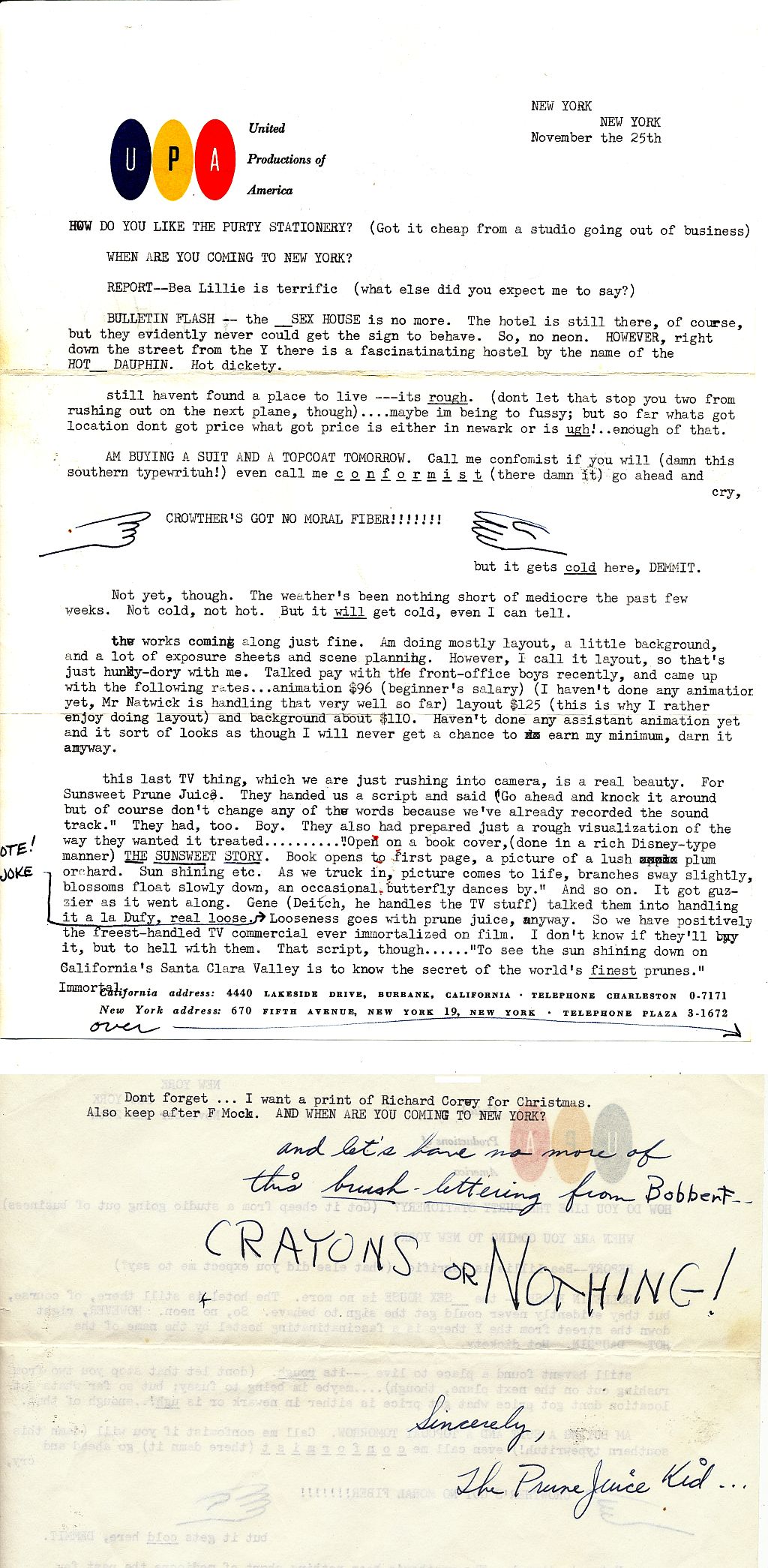 Â As a tribute to both Duane Crowther and the fine (battered) city of New York, we present his letters to Bob (Bobbert) and Cima Balser from Nov. 12th and 25th, 1952. Duane could stay at the YMCA in N.Y. in those days for $2.50 a night! Winter coats were only $125.00, and he was doing TV commercial layout for the great Gene Deitch! What a life, seeing Beatrice Lillie performing live, dishing on Radio City Music Hall and the Rockettes, going to art shows at the Museum of Modern Art. This was New York City at it’s most artistic and user-friendly. I thought that Mike Sporn and Greg Ford in particular might enjoy reading these. I love Duane’s drawing on the back of the Nov. 12th letter, note he’s walking on a sidewalk heating grate! He draws himself a little like Waldo, don’t you think? I love Duane’s jokes about the Sunsweet Prunes commercial he worked on in the 11-25 letter: “Looseness goes with prune juice, anyway.” (He writes in the margin: “Note! Joke..((It’s a bit cut-off from my scanner.))) These letters are reproduced through the courtesy of Cathy Karol-Crowther, Duane’s widow. It’s so wonderful that Bob and Cima Balser kept these letters.
 As a tribute to both Duane Crowther and the fine (battered) city of New York, we present his letters to Bob (Bobbert) and Cima Balser from Nov. 12th and 25th, 1952. Duane could stay at the YMCA in N.Y. in those days for $2.50 a night! Winter coats were only $125.00, and he was doing TV commercial layout for the great Gene Deitch! What a life, seeing Beatrice Lillie performing live, dishing on Radio City Music Hall and the Rockettes, going to art shows at the Museum of Modern Art. This was New York City at it’s most artistic and user-friendly. I thought that Mike Sporn and Greg Ford in particular might enjoy reading these. I love Duane’s drawing on the back of the Nov. 12th letter, note he’s walking on a sidewalk heating grate! He draws himself a little like Waldo, don’t you think? I love Duane’s jokes about the Sunsweet Prunes commercial he worked on in the 11-25 letter: “Looseness goes with prune juice, anyway.” (He writes in the margin: “Note! Joke..((It’s a bit cut-off from my scanner.))) These letters are reproduced through the courtesy of Cathy Karol-Crowther, Duane’s widow. It’s so wonderful that Bob and Cima Balser kept these letters.


  Yowp just put the b/w “tab’ versions of these half-page Yogi Bear Sunday pages from Nov. 1962 on his website. Go there by clicking the link to your right and read what he has to say about the comics. Harvey Eisenberg drew and lettered all four of these. His “Yogi Bear” logos were always distinctive, in a very slick way. I, too like the cow/fresh buttermilk gag in the 11-25 page. Duane would hate his letters being on the same page as these H-B Sundays. He never had any respect for their cartoons, going all the way back to the first Tom and Jerrys. He DID like some of the artists who worked on the H-B stuff, however. He really got along well with George Nicholas, and I remember the two of them playing chess at Fred Calvert’s old studio. Remember California readers, vote “Yes” on Prop. 37! Go to Itza Cat’s Facebook page: www.facebook.com/someothercat to see his political posters about “Frankenfoods”. See you here again soon!
 Yowp just put the b/w “tab’ versions of these half-page Yogi Bear Sunday pages from Nov. 1962 on his website. Go there by clicking the link to your right and read what he has to say about the comics. Harvey Eisenberg drew and lettered all four of these. His “Yogi Bear” logos were always distinctive, in a very slick way. I, too like the cow/fresh buttermilk gag in the 11-25 page. Duane would hate his letters being on the same page as these H-B Sundays. He never had any respect for their cartoons, going all the way back to the first Tom and Jerrys. He DID like some of the artists who worked on the H-B stuff, however. He really got along well with George Nicholas, and I remember the two of them playing chess at Fred Calvert’s old studio. Remember California readers, vote “Yes” on Prop. 37! Go to Itza Cat’s Facebook page: www.facebook.com/someothercat to see his political posters about “Frankenfoods”. See you here again soon!
The Duane Crowther Letters Part One
From the collection of Robert Balser, we present a few letters that my late friend and boss, Duane Crowther, wrote in the early 1950s mostly to Robert Balser, or as Duane called him: “Bobbert”. The first letter from 1-29-1951 is written to a Major Harback, who evidently had some kind of Armed Forces Animation studio. Duane had been inducted into the Army as a Corporal (Korean War era), and was trying to get a job doing animation. Duane had been working for Les Novros (Graphic Films) for 4 years and names the titles of some of the early training films he worked on. He also mentions his stint as an inbetweener at UPA, where he worked on “Georgie and the Dragon” among other cartoons. Duane was well-versed in the technical side of animation, could do “technical animation” which nowadays is 100% digital, but in the 1950s was done with drafting tools and elipse guides and usually illustrated how motors worked. In the second letter, written to Bob Balser from Tokyo, Japan on March 5, 1952, Duane gives a snapshot of his experiences stationed in the Rising Sun land. He was classified a Clerk Typist (!) but kept trying to get animation work. He wound up playing a lot of Ping-Pong and Golf, a sport he continued to play for the rest of his life. He evidently knew and admired the early avant garde filmmaker, Flora Mock (he calls her F. Mock), who made “Paper Moon” in 1949 and “Waiting” (Duane calls it “Watiting”) in 1952. Duane produced his UCLA student film, “Blum Blum” about that same time, 1949. Maybe he met Flora Mock at UCLA. As to what “Richard Corey” is, an educated guess might be that it was an experimental film Bob Balser made in the early 1950s illustrating the poem of the same name. You can read it on Ixquick or Google. It’s about an apparently well-adjusted man who commits suicide. I love Duane’s little gag on the second page of his letter to Balser. These letters are coming to you with the kind permission of Duane’s widow, Cathy Karol Crowther. You will read about Duane’s early years at UPA New York, working with Gene Deitch, Grim Natwick and other folks in subsequent letters.





 Â Krazy Kat this time is from 8-4 to 8-9-1941, Krazy adopts a Jelly Fish, who he names “Current” AND “Currant”. Krazy and Ignatz spend the whole week trading quips and puns about Krazy’s new pet. I like the wind-up to the series as Ignatz gets in the final pun: “In a Jam, eh?”
 Krazy Kat this time is from 8-4 to 8-9-1941, Krazy adopts a Jelly Fish, who he names “Current” AND “Currant”. Krazy and Ignatz spend the whole week trading quips and puns about Krazy’s new pet. I like the wind-up to the series as Ignatz gets in the final pun: “In a Jam, eh?”






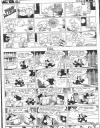 Â Felix, in the strips from 9-23 to 9-29-1935, paddles out to the ship from the Ape’s Island, and dons the Idol’s clay shell to disguise himself as he stows away. In the Sunday page, Felix helps a comic artist get a job as he sprays the comics editor with laughing gas from the Professor’s lab. The Nitrous Oxide induced guffaws land the cartoonist a job. Felix always looks out for the little guy.
 Felix, in the strips from 9-23 to 9-29-1935, paddles out to the ship from the Ape’s Island, and dons the Idol’s clay shell to disguise himself as he stows away. In the Sunday page, Felix helps a comic artist get a job as he sprays the comics editor with laughing gas from the Professor’s lab. The Nitrous Oxide induced guffaws land the cartoonist a job. Felix always looks out for the little guy.



 Â To help Yowp out, we present third page versions of “The Flintstones” Sunday pages from Oct. 1962 in color. According to Mark Christiansen who commented before, these are the work of Dick Bickenbach, ace layout man, animator, and Joe Barbera’s right hand man in the MGM days. If you visit Yowp’s blog, you can see the top tier of these strips and read his comments on them. These were all snipped from the St. Louis Globe-Democrat in the days when “The Flintheads”, as my Dad called them, were fresh and new.
 To help Yowp out, we present third page versions of “The Flintstones” Sunday pages from Oct. 1962 in color. According to Mark Christiansen who commented before, these are the work of Dick Bickenbach, ace layout man, animator, and Joe Barbera’s right hand man in the MGM days. If you visit Yowp’s blog, you can see the top tier of these strips and read his comments on them. These were all snipped from the St. Louis Globe-Democrat in the days when “The Flintheads”, as my Dad called them, were fresh and new.
   It’s good to be posting again, sorry for the long hiatus, but after our trip to San Luis Obisbo and driving more than 800 miles, I just didn’t feel like concentrating on the weblog the way I should. More to come, pretty soon readers! Remember to click on the thumbnails to blow them up, this is especially important to read Duane’s letters.
So Long For Awhile (’til Oct. 14th)


 Â We won’t be around for a couple of weeks, so to tide you over, we risk enraging Yowp by posting the Oct. 1962 Yogi Sundays a little early. I’ve included a scan of the original art for the Oct. 7th episode, drawn by Harvey Eisenberg. It’s a bit choppy, because the original was so huge that I could only scan it in little pieces, then assemble it like a puzzle. Harvey did the art for the entire month’s worth of strips.
 We won’t be around for a couple of weeks, so to tide you over, we risk enraging Yowp by posting the Oct. 1962 Yogi Sundays a little early. I’ve included a scan of the original art for the Oct. 7th episode, drawn by Harvey Eisenberg. It’s a bit choppy, because the original was so huge that I could only scan it in little pieces, then assemble it like a puzzle. Harvey did the art for the entire month’s worth of strips.
 Â Myrtle, from 4-21-47 to 4-26-47, I like Sampson kicking the radio in the 4-21 and all the references to neighbor Smaltz in the 4-25 and 4-26 strips. The little bird characters that Fisher drew so well make some appearances too. We’ll see you anon, I’ll be painting up the coast with my wife for awhile. ‘Til then, browse the archives and copy your favorite strips.
 Myrtle, from 4-21-47 to 4-26-47, I like Sampson kicking the radio in the 4-21 and all the references to neighbor Smaltz in the 4-25 and 4-26 strips. The little bird characters that Fisher drew so well make some appearances too. We’ll see you anon, I’ll be painting up the coast with my wife for awhile. ‘Til then, browse the archives and copy your favorite strips.
Junior Times in January 1927 Pt. Two
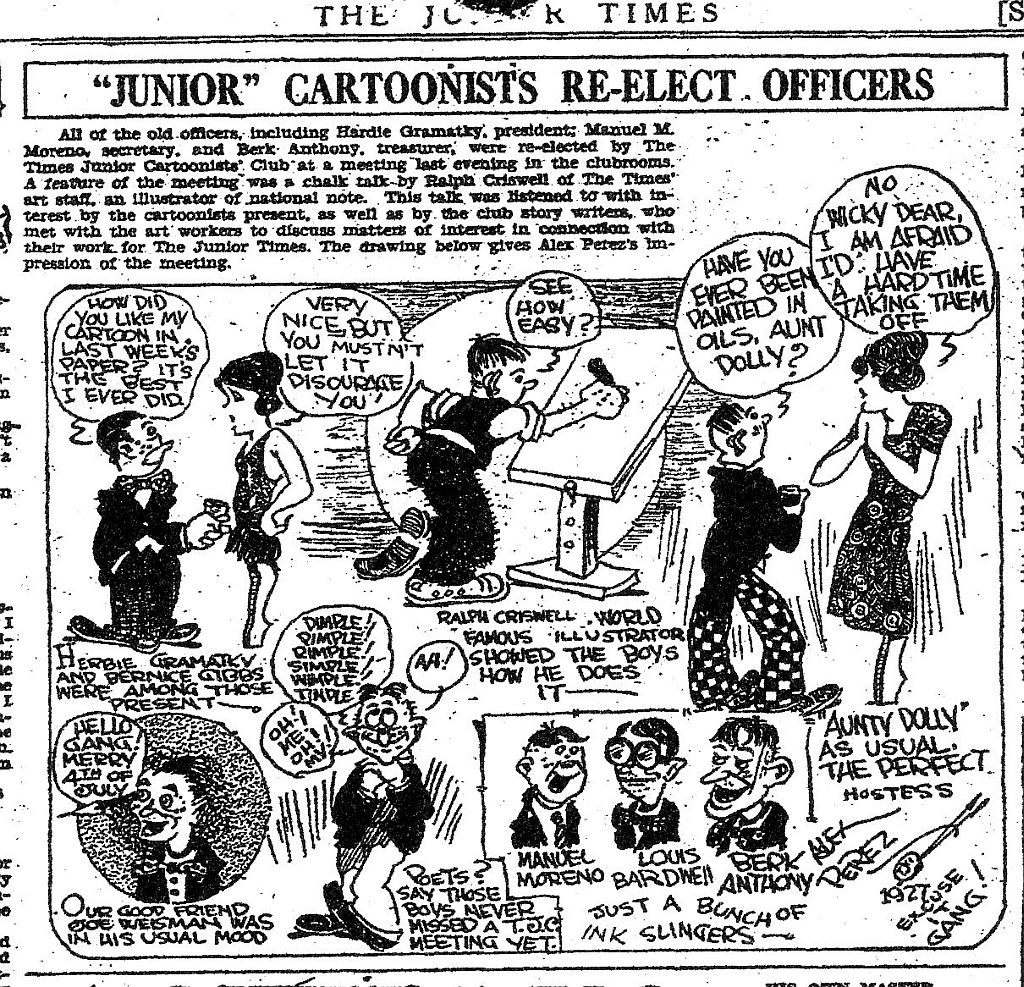








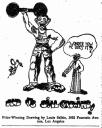


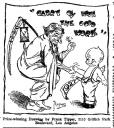
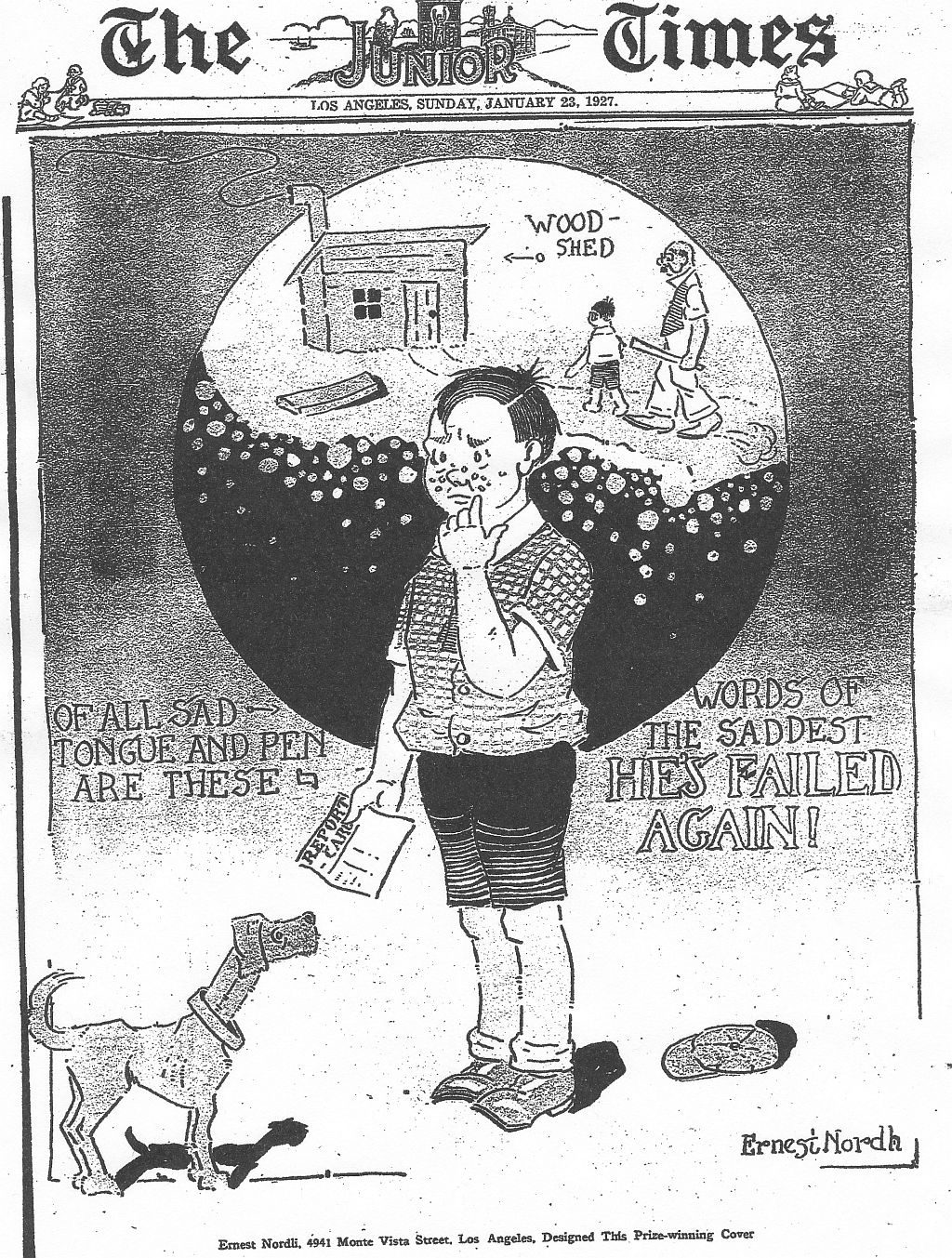
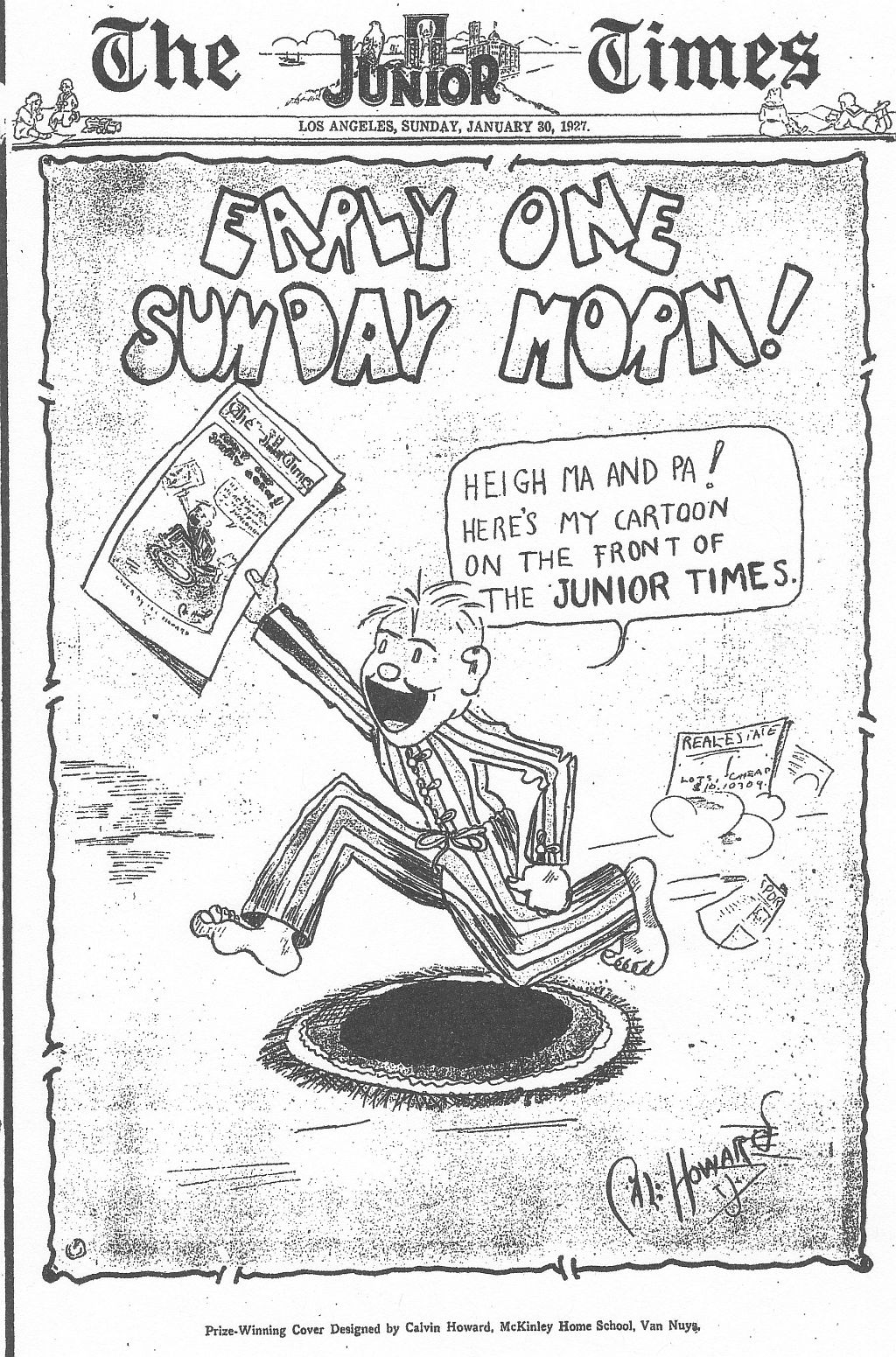 Â Here is part two of the January 16th, 23rd and 30th 1927 issues of the Junior Times. Alex Perez leads off with his cartoon about a meeting of the Times Junior Club. He shows a meeting between Aunt Dolly and Bob Wickersham (she calls him “Wicky”), and Manuel Moreno, Secretary of the Club, Â is caricatured. There’s also a photo up there of “Wick”, when he was running for President of the T.J.C.. There are new episodes of the comic strips “Hezy Tate” and “Pearl Handle” by Phil De Lara, “Jim Dandy” by Morey Reden, “Fishy Tales” by I. Ellis and “Tiny Brains” by Louie (Leo) Salkin. You’ll see a new year’s drawing by Frank Tipper in which 1927 is a ringer for a kewpie doll. As a coda, don’t miss the 10 dollar prize covers by Ernest (Ernie) Nordli and Cal Howard! Note that Cal has created an “infinity” cover. Â All these artists didn’t know it in 1927, but they were about to enter the animated cartoon profession, kicked off in 1928 by a new “talkie” cartoon featuring a musical mouse.
 Here is part two of the January 16th, 23rd and 30th 1927 issues of the Junior Times. Alex Perez leads off with his cartoon about a meeting of the Times Junior Club. He shows a meeting between Aunt Dolly and Bob Wickersham (she calls him “Wicky”), and Manuel Moreno, Secretary of the Club,  is caricatured. There’s also a photo up there of “Wick”, when he was running for President of the T.J.C.. There are new episodes of the comic strips “Hezy Tate” and “Pearl Handle” by Phil De Lara, “Jim Dandy” by Morey Reden, “Fishy Tales” by I. Ellis and “Tiny Brains” by Louie (Leo) Salkin. You’ll see a new year’s drawing by Frank Tipper in which 1927 is a ringer for a kewpie doll. As a coda, don’t miss the 10 dollar prize covers by Ernest (Ernie) Nordli and Cal Howard! Note that Cal has created an “infinity” cover.  All these artists didn’t know it in 1927, but they were about to enter the animated cartoon profession, kicked off in 1928 by a new “talkie” cartoon featuring a musical mouse.
Flintstones Sept. 1962 for Yowp



 Â In answer to Yowp’s post today, here are the third-page versions of the Flintstones Sunday comics from September of 1962. I was comic-cuttin’ crazy in that halcyon year, spending hours trimming strips out of the St. Louis Post-Dispatch and Globe-Democrat. In retrospect, my time would have been better spent in drawing my own cartoons! I couldn’t see ahead to this bloggin’ era we live in now, so all my strip cuttings have use now as visual backstops for other blogs. Make sure you click “Yowp” on the blogroll over to the right, and you will see the 1/2 page versions of these strips in black and white. Our family loved the Flintstones when they first aired in 1960. My Grandma Vera laughed at the way Fred WALKED! I have no idea who drew these particular pages, not Harvey Eisenberg anyway. I didn’t save as many of these pages as Yogi Bear, perhaps the Globe-Democrat dropped the strip after only a few years. You’ll find that most comic strips that were TV or radio centered only lasted about as long as the heyday of the show from which they were derived. I’m enjoying doing more posts, for now. Just click on the thumbnails to see them larger.
 In answer to Yowp’s post today, here are the third-page versions of the Flintstones Sunday comics from September of 1962. I was comic-cuttin’ crazy in that halcyon year, spending hours trimming strips out of the St. Louis Post-Dispatch and Globe-Democrat. In retrospect, my time would have been better spent in drawing my own cartoons! I couldn’t see ahead to this bloggin’ era we live in now, so all my strip cuttings have use now as visual backstops for other blogs. Make sure you click “Yowp” on the blogroll over to the right, and you will see the 1/2 page versions of these strips in black and white. Our family loved the Flintstones when they first aired in 1960. My Grandma Vera laughed at the way Fred WALKED! I have no idea who drew these particular pages, not Harvey Eisenberg anyway. I didn’t save as many of these pages as Yogi Bear, perhaps the Globe-Democrat dropped the strip after only a few years. You’ll find that most comic strips that were TV or radio centered only lasted about as long as the heyday of the show from which they were derived. I’m enjoying doing more posts, for now. Just click on the thumbnails to see them larger.
L.A. Junior Times Jan. 1927 Part One





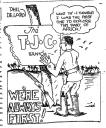



  The blog strikes again with more cartoons from the kid cartoonists of the Los Angeles Junior Times! This time we have the goods from Jan. 2nd and 9th, 1927. The lead-off spot is given over to Isadore Ellis, who was one of the great Looney Tunes animators. He was paid 10 silver dollars for this cover of three funny cats singing about a dog who didn’t belong to the T.J.C. We have Ellis’ “Dunk Dank”, a Bob Wickersham “Fido Bark” and a Phil De Lara “Hezy Tate” episode from Jan. 2, 1927. The Times liked “Fido Bark” so much that they ran two of him in the Jan. 2nd issue. We also feature a Wick “Happy New Year” drawing, three “Pearl Handle” panels, another “Hezy Tate” strip (Jan. 9th), and a T.J.C. booster drawing, all by Phil De Lara. There’s also a “Highshine Joe” and a grocery store gag by Morris Redensky (Reden), a Lee Morehouse “Macy” strip and another T.J.C. promo drawing by animation pioneer Frank Tipper. Remember to click on the thumbnail images to see them larger.
 The blog strikes again with more cartoons from the kid cartoonists of the Los Angeles Junior Times! This time we have the goods from Jan. 2nd and 9th, 1927. The lead-off spot is given over to Isadore Ellis, who was one of the great Looney Tunes animators. He was paid 10 silver dollars for this cover of three funny cats singing about a dog who didn’t belong to the T.J.C. We have Ellis’ “Dunk Dank”, a Bob Wickersham “Fido Bark” and a Phil De Lara “Hezy Tate” episode from Jan. 2, 1927. The Times liked “Fido Bark” so much that they ran two of him in the Jan. 2nd issue. We also feature a Wick “Happy New Year” drawing, three “Pearl Handle” panels, another “Hezy Tate” strip (Jan. 9th), and a T.J.C. booster drawing, all by Phil De Lara. There’s also a “Highshine Joe” and a grocery store gag by Morris Redensky (Reden), a Lee Morehouse “Macy” strip and another T.J.C. promo drawing by animation pioneer Frank Tipper. Remember to click on the thumbnail images to see them larger.
Coming soon, Part TWO of the kid cartoonists’ output from Jan. 1927. They wore out a few Estabrooks that month. As I said in previous posts, 1926 and 1927 were the prime years in the Junior Times for amateur-turning-pro cartoonists. In 1928 there were fewer cartoons published, and in 1929, the fashion turned to puzzles and “find the hidden Chinese fishermen” type drawings. Keep reading and commenting, folks, and I’ll try to post more often.
Felix and Krazy Purr Again
![]()




 Â The blog is back with cats! Krazy (7-28 to 8-2-1941) is rife with bricks and Ignatz gags. I especially like the 7-30 strip, Ignatz is leaving the house and warns Krazy to “don’t let the candle go out.” Krazy promptly locks the door and the candle stays in!
 The blog is back with cats! Krazy (7-28 to 8-2-1941) is rife with bricks and Ignatz gags. I especially like the 7-30 strip, Ignatz is leaving the house and warns Krazy to “don’t let the candle go out.” Krazy promptly locks the door and the candle stays in!
![]()





  Felix (9-16 to 9-22-1935) has the sailors constantly changing their opinion of Felix from jinx to good luck charm, since he found an ancient hollow idol in the underground city. The idol has a curse on it and seems to cause a volcano to erupt in a beautifully rendered panel in the 9-19, and the frightened sailors high tail it back to the ship, leaving poor Felix to paddle his way out of there in the hollow idol. The idol becomes quite a prop in the strips to come, don’t miss ’em! In the Sunday, Felix continues to stay at the professor’s house and get injections to make him think he’s had a chicken dinner. Felix finds a fluid to make him invisible and get past the professor to some real chicken, but the Prof. feeds a mouse with “Powite” solution and Felix is punched to pieces.
 Felix (9-16 to 9-22-1935) has the sailors constantly changing their opinion of Felix from jinx to good luck charm, since he found an ancient hollow idol in the underground city. The idol has a curse on it and seems to cause a volcano to erupt in a beautifully rendered panel in the 9-19, and the frightened sailors high tail it back to the ship, leaving poor Felix to paddle his way out of there in the hollow idol. The idol becomes quite a prop in the strips to come, don’t miss ’em! In the Sunday, Felix continues to stay at the professor’s house and get injections to make him think he’s had a chicken dinner. Felix finds a fluid to make him invisible and get past the professor to some real chicken, but the Prof. feeds a mouse with “Powite” solution and Felix is punched to pieces.
    I’m playing catch-up with the blog now that it’s back up, and soon I’ll do another “Junior Times” post (they are the hardest to do). Until then, thanks everyone for being so patient and continuing to read the Catblog.
It’s Great to Be Bloggin’ Again!
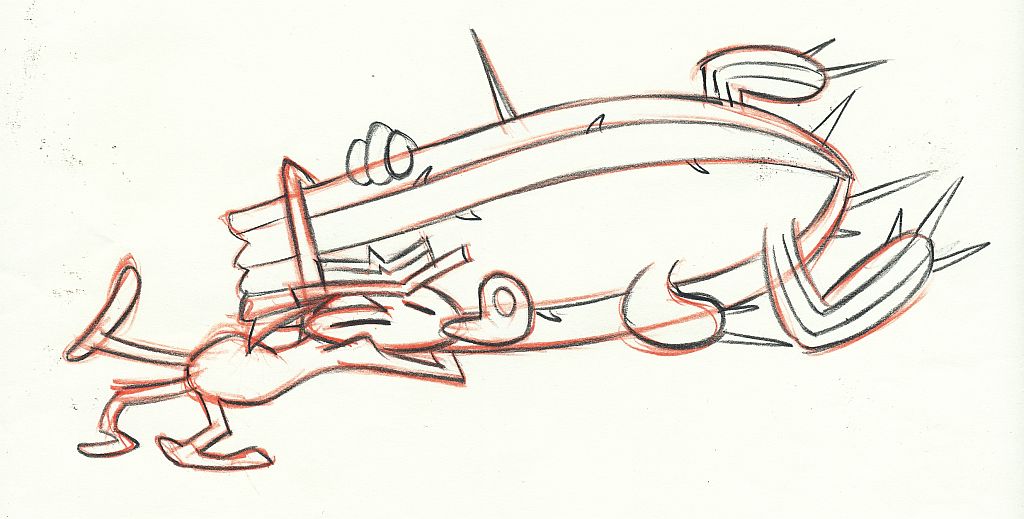 Â The Blog froze up about August 28th. A lot of “Deprecated” messages appeared on the top of the page and I couldn’t figure out how to get them off. The entire site was frozen, and I couldn’t access any of the controls, post or edit comments. I appealed to many people for help, and many tried, thanks Adrian, Charles and Thad! Greg Ford, as usual, was the biggest help. He remembered that our web host is GoDaddy.com. The kind people at GoDaddy were able to talk me through the reset process for WordPress, on which this blog is written. Seems I have an old version (5 years old) of WordPress which wasn’t syncing up with newer Plugins and fonts. Now I’ve been updated to Vers. 2.1.3, and you will notice that the masthead and type font is just a little different. I only have two Plugins on the site, both of which are not activated. Whew! The things you have to know just to run a blog! Thanks again kind friends, for putting up with my extreme ignorance regarding the fine points of Plugins and Vers. 2.1.3!
 The Blog froze up about August 28th. A lot of “Deprecated” messages appeared on the top of the page and I couldn’t figure out how to get them off. The entire site was frozen, and I couldn’t access any of the controls, post or edit comments. I appealed to many people for help, and many tried, thanks Adrian, Charles and Thad! Greg Ford, as usual, was the biggest help. He remembered that our web host is GoDaddy.com. The kind people at GoDaddy were able to talk me through the reset process for WordPress, on which this blog is written. Seems I have an old version (5 years old) of WordPress which wasn’t syncing up with newer Plugins and fonts. Now I’ve been updated to Vers. 2.1.3, and you will notice that the masthead and type font is just a little different. I only have two Plugins on the site, both of which are not activated. Whew! The things you have to know just to run a blog! Thanks again kind friends, for putting up with my extreme ignorance regarding the fine points of Plugins and Vers. 2.1.3!
 Â I’m not going to do the full quota of comics this time, I’ve been off the blog for so long that I’m going to sashay into it kinda gentle-like. Here’s Myrtle from 4-14 to 4-19-1947 by the great Dudley Fisher. My favorite from the week’s batch is the 4-16, which contains a special preview of “what a Dickens” Myrtle will be like when she’s 16! She has a figure, but even better is the stretched-out pose that Fisher uses to show her energetic attitude.
 I’m not going to do the full quota of comics this time, I’ve been off the blog for so long that I’m going to sashay into it kinda gentle-like. Here’s Myrtle from 4-14 to 4-19-1947 by the great Dudley Fisher. My favorite from the week’s batch is the 4-16, which contains a special preview of “what a Dickens” Myrtle will be like when she’s 16! She has a figure, but even better is the stretched-out pose that Fisher uses to show her energetic attitude.




 Â I felt very unhappy that I couldn’t post the Sept. 1962 Yogi Bear Sunday pages due to the blog freeze. Here they are at last, in response to Yowp’s post of Sept. 2nd. They all seem to be by Harvey Eisenberg this time. The 9-30 strip is rather poignant, as President John F. Kennedy would be shot down Nov. 22, 1963, a little more than a year after this strip was published. Caroline Kennedy, who is the little girl in the last panel of the 9-30 Yogi page, Â is still around, is a political presence, and a supporter and severe critic of President Obama. Please click the blogroll to the right of the page, to go to Yowp’s website and read his comments on these strips.
 I felt very unhappy that I couldn’t post the Sept. 1962 Yogi Bear Sunday pages due to the blog freeze. Here they are at last, in response to Yowp’s post of Sept. 2nd. They all seem to be by Harvey Eisenberg this time. The 9-30 strip is rather poignant, as President John F. Kennedy would be shot down Nov. 22, 1963, a little more than a year after this strip was published. Caroline Kennedy, who is the little girl in the last panel of the 9-30 Yogi page,  is still around, is a political presence, and a supporter and severe critic of President Obama. Please click the blogroll to the right of the page, to go to Yowp’s website and read his comments on these strips.
    I’ve missed, and haven’t missed writing this blog these past few weeks. It can be a time-consuming task to put this little squeak together. Some nice readers wrote to me and said they would miss this electronic rag if I quit doing it, so for them I’ll continue as long as the software lets me! I’ll try to get some more of my favorite (and yours) Felix, Krazy and L.A. Junior Times comics back here (where they belong) very soon. Computers can still be very formidable critters to deal with at times, especially when you can’t figure out what “Deprecated warnings” mean, let alone “Codex”. Good luck with your blogs, you content providers! See you soon.
Adios Barker Bill
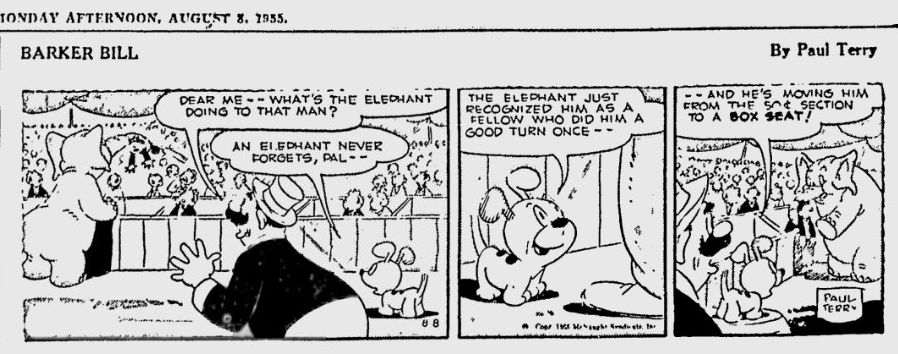









  Well Folks, here are the last three weeks of Barker Bill strips available to me, from 8-8-55 to 8-25-55. If you find more of them, please write to me, I still don’t know the actual end date of the strip. These are all gag-a-day circus strips. The gag in the 8-24 was used by Stan Laurel for a phonograph record that he made with Oliver Hardy on their trip to England in the 1930s! Since it takes me quite a long time to get all the Jr. Times material on here, I won’t be replacing Barker Bill with another strip.
 Well Folks, here are the last three weeks of Barker Bill strips available to me, from 8-8-55 to 8-25-55. If you find more of them, please write to me, I still don’t know the actual end date of the strip. These are all gag-a-day circus strips. The gag in the 8-24 was used by Stan Laurel for a phonograph record that he made with Oliver Hardy on their trip to England in the 1930s! Since it takes me quite a long time to get all the Jr. Times material on here, I won’t be replacing Barker Bill with another strip.
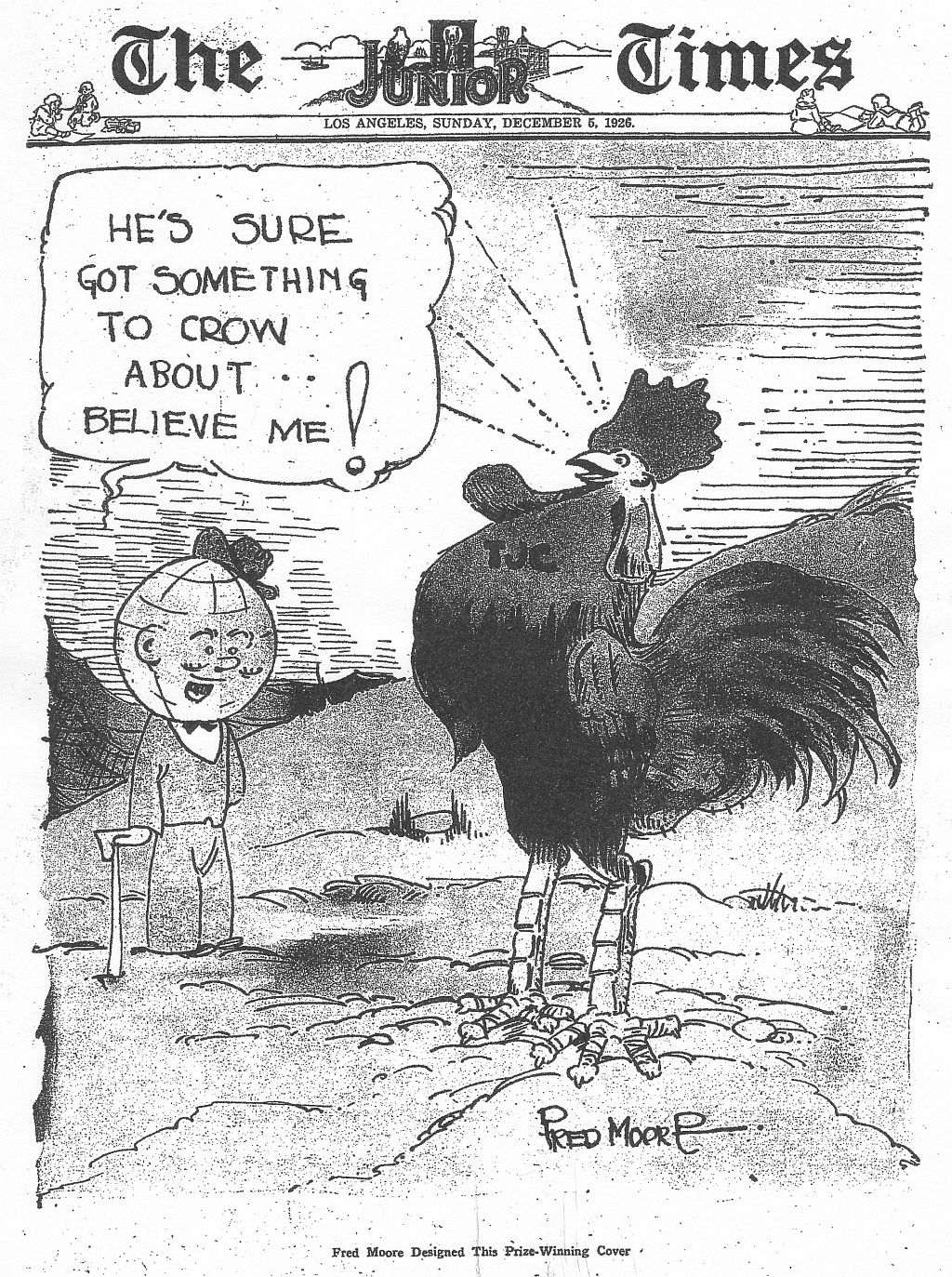








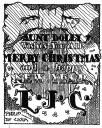





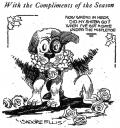
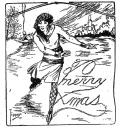
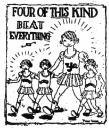

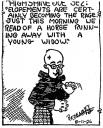



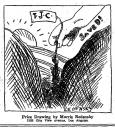







 Â The L.A. Junior Times for Dec. 1926 burst forth with a comicopia of material from Fred Moore (rooster cover), Phil De Lara, with his cover, Pearl Handle panel and Hezy Tate strip. Note in his bio from 3-11-28, that his ambition was to become an editorial newspaper cartoonist (animation wasn’t on his radar yet), he was 14 years old in 1926 when he did all these cartoons for Aunt Dolly. You’ll see some episodes of “Dunk Dank” by I. Ellis, a Morris Redensky (Morey Reden) portfolio with episodes of “Hank’s Hash House”, “High Shine Joe”, “The Snickle Bros.” and many more drawings he made to promote the T.J.C. There are also three “Lucky Lem” strips by Bill Zaboly, a “Fido Bark” by Bob Wickersham and a T.J.C. promo drawing by Lee Morehouse. To enjoy all this work by future animation and comic strip greats, just click on the thumbnails. 1926 and early 1927 were the high points for the Junior Times for kid cartoonists. The Times published a great deal of their work, with several pages per week, loaded with amateur comic strips. The Junior Times cut back on the cartoons as 1928 chugged along, featuring more games and puzzles for the “juniors”, as we will see later on.
 The L.A. Junior Times for Dec. 1926 burst forth with a comicopia of material from Fred Moore (rooster cover), Phil De Lara, with his cover, Pearl Handle panel and Hezy Tate strip. Note in his bio from 3-11-28, that his ambition was to become an editorial newspaper cartoonist (animation wasn’t on his radar yet), he was 14 years old in 1926 when he did all these cartoons for Aunt Dolly. You’ll see some episodes of “Dunk Dank” by I. Ellis, a Morris Redensky (Morey Reden) portfolio with episodes of “Hank’s Hash House”, “High Shine Joe”, “The Snickle Bros.” and many more drawings he made to promote the T.J.C. There are also three “Lucky Lem” strips by Bill Zaboly, a “Fido Bark” by Bob Wickersham and a T.J.C. promo drawing by Lee Morehouse. To enjoy all this work by future animation and comic strip greats, just click on the thumbnails. 1926 and early 1927 were the high points for the Junior Times for kid cartoonists. The Times published a great deal of their work, with several pages per week, loaded with amateur comic strips. The Junior Times cut back on the cartoons as 1928 chugged along, featuring more games and puzzles for the “juniors”, as we will see later on.





 Â From 7-21 to 7-26-1941, Ignatz mostly takes to the air to bombard Krazy with bricks as he parachutes down. I like Offissa Pupp’s flying club in the 7-25. I don’t quite understand what Ignatz is using to hold down a brick evidently filled with helium gas in the 7-24. Is it a wad of gum, or a rock? Offissa Pupp knocks it off the brick, and the brick becomes a “billoom”.
 From 7-21 to 7-26-1941, Ignatz mostly takes to the air to bombard Krazy with bricks as he parachutes down. I like Offissa Pupp’s flying club in the 7-25. I don’t quite understand what Ignatz is using to hold down a brick evidently filled with helium gas in the 7-24. Is it a wad of gum, or a rock? Offissa Pupp knocks it off the brick, and the brick becomes a “billoom”.






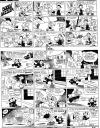 Â Felix, from 9-9 to 9-14-1935 finds him waiting for rescue in the underground city. The sailors decide that Felix is “a pest and a nuisance” in the 9-9, and Felix stays underground to escape their wrath (everybody has such short memories in Messmer’s world). Felix discovers a one-eyed idol in the tunnels and uses it as a disguise, it comes in handy, as you shall soon see. The Sunday has Felix swearing off dreaming, as he tries to get adopted by an old professor who has invented an “energy drink” called Zowite. At first the Prof is hostile to Felix invading his home, but when Felix drinks some of the Zowite, thinking it is milk, he becomes quite powerful and beats up the Prof. The Prof decides to keep Felix around as an experimental cat!
 Felix, from 9-9 to 9-14-1935 finds him waiting for rescue in the underground city. The sailors decide that Felix is “a pest and a nuisance” in the 9-9, and Felix stays underground to escape their wrath (everybody has such short memories in Messmer’s world). Felix discovers a one-eyed idol in the tunnels and uses it as a disguise, it comes in handy, as you shall soon see. The Sunday has Felix swearing off dreaming, as he tries to get adopted by an old professor who has invented an “energy drink” called Zowite. At first the Prof is hostile to Felix invading his home, but when Felix drinks some of the Zowite, thinking it is milk, he becomes quite powerful and beats up the Prof. The Prof decides to keep Felix around as an experimental cat!
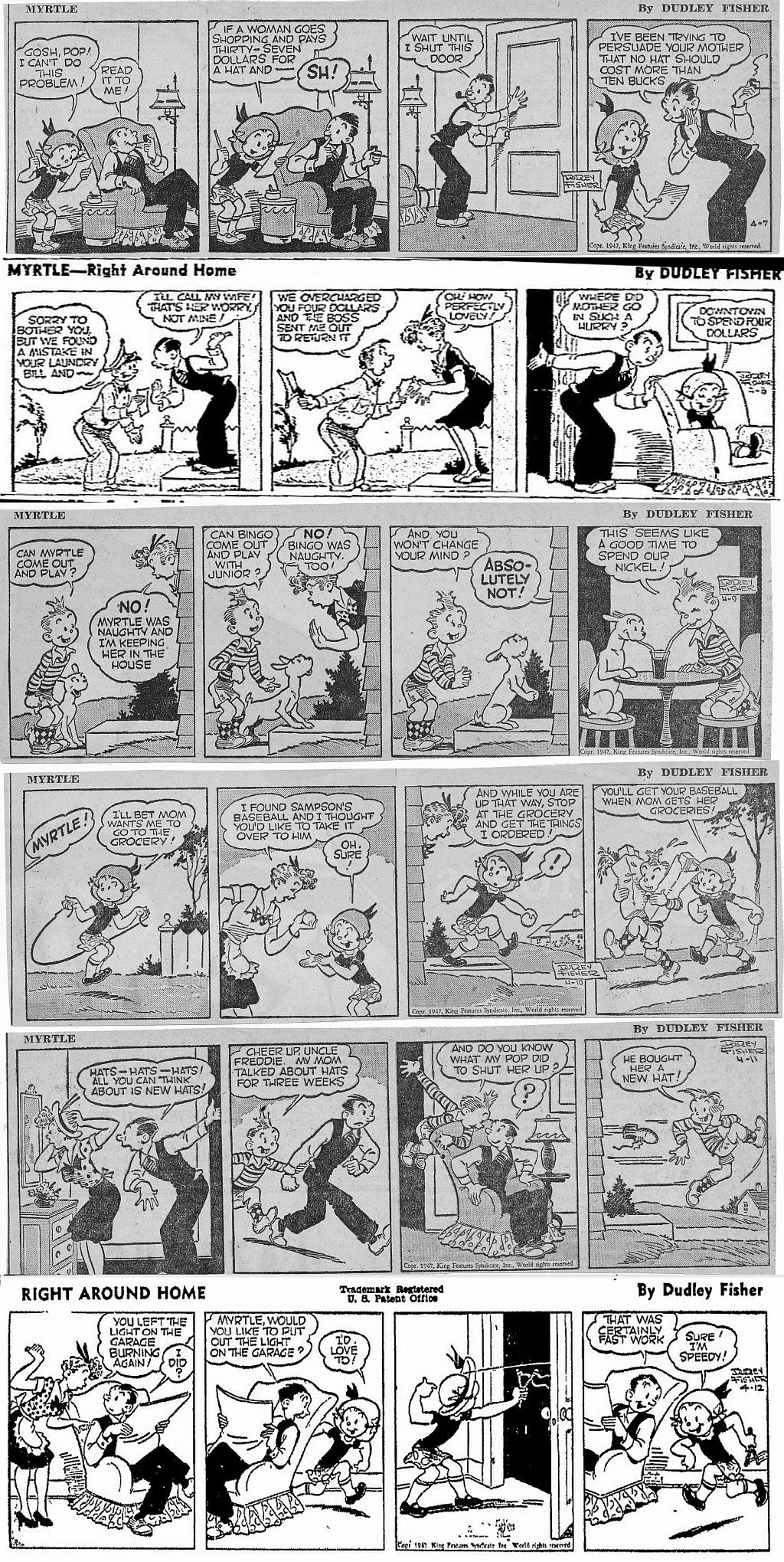  Here is Myrtle from 4-7 to 4-12-1947. I love Sampson’s poses in the 4-11, as he hangs off the back of Uncle Freddie’s chair, and makes a hasty exit in the last panel, followed by his Uncle’s shoe. I like Myrtle’s attitude in the 4-12 as she nonchalantly shoots out the garage light with her slingshot. Fred commends her on her “fast work”, to which she saucily remarks, “I’m speedy!”
 Here is Myrtle from 4-7 to 4-12-1947. I love Sampson’s poses in the 4-11, as he hangs off the back of Uncle Freddie’s chair, and makes a hasty exit in the last panel, followed by his Uncle’s shoe. I like Myrtle’s attitude in the 4-12 as she nonchalantly shoots out the garage light with her slingshot. Fred commends her on her “fast work”, to which she saucily remarks, “I’m speedy!”

  Here’s “The Flintstones” Sunday pages from 8-12 and 8-26-1962. These are the earliest examples of the strip that I have, and I’m using them here to augment Yowp’s recent post on “Flintstone Weekend Comics”. Just click the link over on the Blogroll to read Yowp’s account of this month’s strips. The 8-12 is the only half-page episode I have. I think Yowp credits Gene Hazelton with the art, Barney looks a lot like he does in the “Swimming Pool” episode. The other Flintstones strips I have are thirds like the 8-26, but I’ll help Yowp as much as I can. He gives good blog. It should be a tad simpler to do posts without Barker Bill, so maybe I’ll squeeze in another one soon. Make sure you go over to the Facebook page, www.facebook.com/someothercat to see some of the credit title designs and the original storyboard for the Cat’s latest cartoon. It may be one of the very last cel-animated cartoons produced in the USA on 35mm film!
 Here’s “The Flintstones” Sunday pages from 8-12 and 8-26-1962. These are the earliest examples of the strip that I have, and I’m using them here to augment Yowp’s recent post on “Flintstone Weekend Comics”. Just click the link over on the Blogroll to read Yowp’s account of this month’s strips. The 8-12 is the only half-page episode I have. I think Yowp credits Gene Hazelton with the art, Barney looks a lot like he does in the “Swimming Pool” episode. The other Flintstones strips I have are thirds like the 8-26, but I’ll help Yowp as much as I can. He gives good blog. It should be a tad simpler to do posts without Barker Bill, so maybe I’ll squeeze in another one soon. Make sure you go over to the Facebook page, www.facebook.com/someothercat to see some of the credit title designs and the original storyboard for the Cat’s latest cartoon. It may be one of the very last cel-animated cartoons produced in the USA on 35mm film!
Stripz Again






 Â Back to the strips, yet again! Here are the next two weeks worth of Barker Bills, 7-25 to 8-4-1955. According to Allan Holtz’s new book on American Comic Strips, there is no ending date for the feature except sometime in 1955. We still have a few more to post. Spot gags continue, featuring Phyllis the strong lady, Little May, Peanuts Perkins, the India Rubber Man and all your favorites!
 Back to the strips, yet again! Here are the next two weeks worth of Barker Bills, 7-25 to 8-4-1955. According to Allan Holtz’s new book on American Comic Strips, there is no ending date for the feature except sometime in 1955. We still have a few more to post. Spot gags continue, featuring Phyllis the strong lady, Little May, Peanuts Perkins, the India Rubber Man and all your favorites!






 Â Felix keeps on walking, from 9-2 to 9-8-1935. Felix and Danny are trapped undergound in the Ancient City all week, and have a surprise encounter with a ground mole in the 9-5. Felix’s adventures in Dreamland finally come to an end in the 9-8 Sunday page. A hobo sets fire to him and wakes Felix from a nightmare. It seems he was going to be ignited in the tobacco for the Giant’s pipe. This is almost the exact situation that Mickey Mouse encountered in “Giantland” Nov. 25th, 1933.
 Felix keeps on walking, from 9-2 to 9-8-1935. Felix and Danny are trapped undergound in the Ancient City all week, and have a surprise encounter with a ground mole in the 9-5. Felix’s adventures in Dreamland finally come to an end in the 9-8 Sunday page. A hobo sets fire to him and wakes Felix from a nightmare. It seems he was going to be ignited in the tobacco for the Giant’s pipe. This is almost the exact situation that Mickey Mouse encountered in “Giantland” Nov. 25th, 1933.





 Â Here’s the Kat from 7-14 to 7-19-1941, the theme is “On Vacation”. At first Krazy is singing and pining away, then he decides to visit a “Heppy Lend Fur Fur Away” and takes Ignatz with him, at the suggestion of Mrs. Kwakk-Wakk. Offissa Pupp follows in the 7-19 with his portable jail. The 7-18 strip has some juicy architecture in it, Herriman style. I love Mrs. Kwakk-Wakk apparently walking right THROUGH a wall in the last panel, leaving an amazed Pupp on the other side.
 Here’s the Kat from 7-14 to 7-19-1941, the theme is “On Vacation”. At first Krazy is singing and pining away, then he decides to visit a “Heppy Lend Fur Fur Away” and takes Ignatz with him, at the suggestion of Mrs. Kwakk-Wakk. Offissa Pupp follows in the 7-19 with his portable jail. The 7-18 strip has some juicy architecture in it, Herriman style. I love Mrs. Kwakk-Wakk apparently walking right THROUGH a wall in the last panel, leaving an amazed Pupp on the other side.






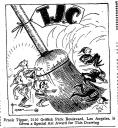


  From the L.A. Junior Times in November, 1926 we present a cross-section of strips and artwork from the soon-to-be-greats. A cover and a Fido Bark strip by Bob Wickersham, a strip by Fred Moore, three “Dunk Danks” and a drawing by Izzy Ellis, three “Lucky Lem” strips and two drawings by Bill Zaboly,  “Macy and Hank” by Lee Morehouse (future Donald Duck animator), two “Hezy Tates” and a “Pearl Handle” drawn by Phil De Lara, together with a photograph of him, an “Average Home” strip and a drawing by Frank Tipper, a Thanksgiving cover by Henry Formhals, who later in the 1930s was a key assistant to Merrill Blosser who did “Freckles and His Friends”. Formhals also took over the art on “Joe Jinks” in the 1930s.  We also have an episode of the “Snickle Bros.” by Morris Redensky. He later shortened his name to Morey Reden and animated and drew comic books in New York and Los Angeles, working for Disney (Pluto’s Playmate, Canine Caddy),Famous (Pop-Pie A La Mode, Lulu’s Birthday Party), Screen Gems (The Schooner the Better, Pickled Puss) and other cartoon studios, ending with “The Grinch Grinches the Cat In The Hat” for Marvel Prods.
 From the L.A. Junior Times in November, 1926 we present a cross-section of strips and artwork from the soon-to-be-greats. A cover and a Fido Bark strip by Bob Wickersham, a strip by Fred Moore, three “Dunk Danks” and a drawing by Izzy Ellis, three “Lucky Lem” strips and two drawings by Bill Zaboly,  “Macy and Hank” by Lee Morehouse (future Donald Duck animator), two “Hezy Tates” and a “Pearl Handle” drawn by Phil De Lara, together with a photograph of him, an “Average Home” strip and a drawing by Frank Tipper, a Thanksgiving cover by Henry Formhals, who later in the 1930s was a key assistant to Merrill Blosser who did “Freckles and His Friends”. Formhals also took over the art on “Joe Jinks” in the 1930s.  We also have an episode of the “Snickle Bros.” by Morris Redensky. He later shortened his name to Morey Reden and animated and drew comic books in New York and Los Angeles, working for Disney (Pluto’s Playmate, Canine Caddy),Famous (Pop-Pie A La Mode, Lulu’s Birthday Party), Screen Gems (The Schooner the Better, Pickled Puss) and other cartoon studios, ending with “The Grinch Grinches the Cat In The Hat” for Marvel Prods.
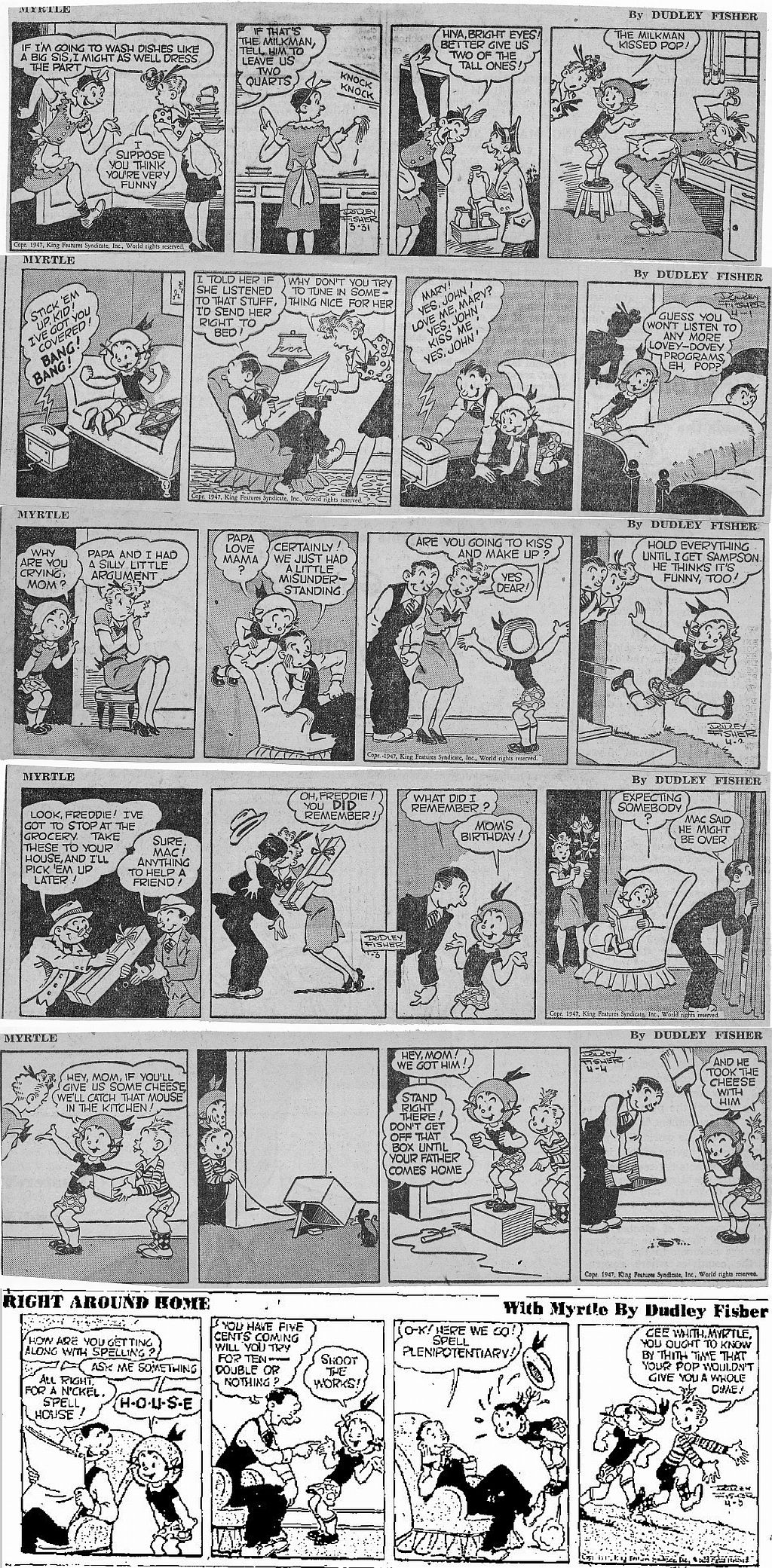 Â Here is Myrtle from 3-31 to 4-5-1947. I like Papa dressing up like a girl in the 3-31 and then getting a kiss from the milkman. That’s a great pose in the last panel as Papa contorts himself at the kitchen sink to wash his mouth out. I also like the spelling word that Papa springs on Myrtle in the 4-5, Dudley Fisher had a good range of intelligence to his gags.
 Here is Myrtle from 3-31 to 4-5-1947. I like Papa dressing up like a girl in the 3-31 and then getting a kiss from the milkman. That’s a great pose in the last panel as Papa contorts himself at the kitchen sink to wash his mouth out. I also like the spelling word that Papa springs on Myrtle in the 4-5, Dudley Fisher had a good range of intelligence to his gags.



 Â Here’s the August, 1962 Yogi Bear Sundays, all drawn by Harvey Eisenberg. I’ll bet that Yowp will like the all-star Hanna-Barbera cast on the teeter-totter in the 8-5. I like the intensity of Yogi’s bowling poses in the 8-26. Well, looks like I’ve beaten you to the dog dish this time, fella! Don’t you bare your teeth at me, be nice!
 Here’s the August, 1962 Yogi Bear Sundays, all drawn by Harvey Eisenberg. I’ll bet that Yowp will like the all-star Hanna-Barbera cast on the teeter-totter in the 8-5. I like the intensity of Yogi’s bowling poses in the 8-26. Well, looks like I’ve beaten you to the dog dish this time, fella! Don’t you bare your teeth at me, be nice!
Goodbye, Frank
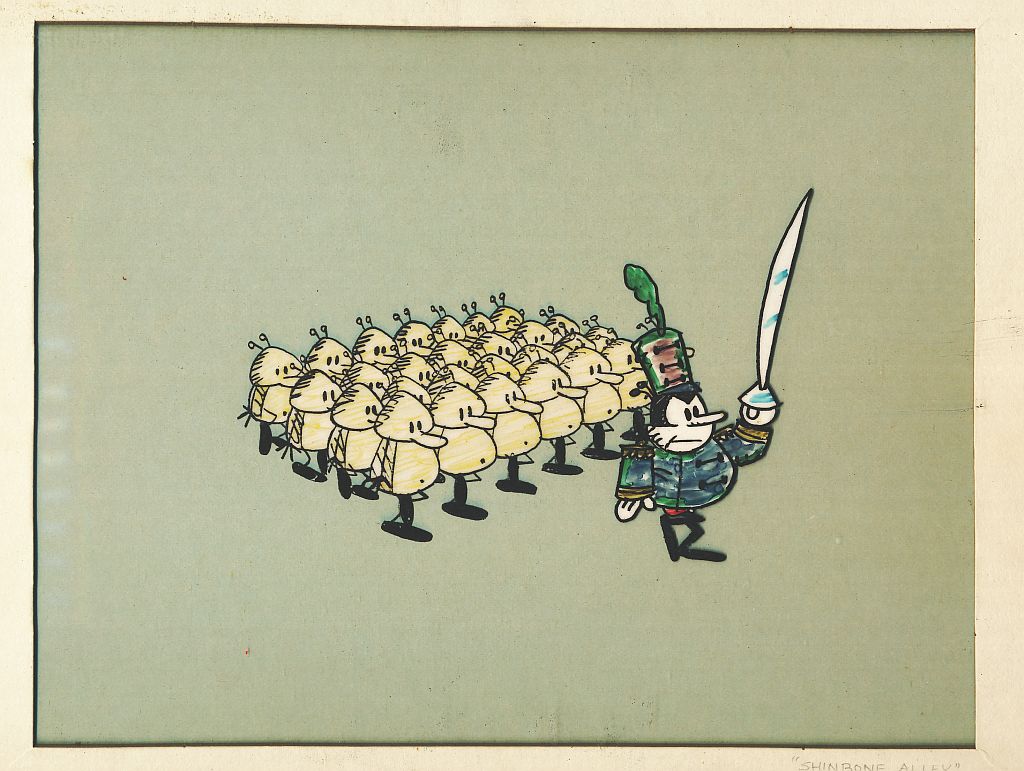 Â This is a cel from my first professional scene of animation. It was used in the “Archy Declares War” sequence from “Shinbone Alley”, which was made in the summer of 1969 at the Colorvision studios over on Sunset. Since then, Channel 28 and now the Church of Scientology have taken over the building. I’ll never forget the way the studio looked like then, we were in a little ramshackle bungalow across from the main lot with the sound stages that had been the Monogram studio in the dim distant past. They actually were shooting soft-core porn features on those stages in 1969. Several of us young bumpkins looked in on the deserted stages during our lunch hour and saw whips, chains and manacles attached to the walls. We wondered what in the heck could they be shooting in there? We got a big clue when a covy of heavily made-up ladies paraded past our bungalow one day, heading for the sound stages. The animator I was assigned to, Frank Andrina, took great amusement at our reactions, chuckling softly to himself. Frank was keying a lot of his extremes in Pentel pen, and I was expected to mimic his line on the inbetweens:
 This is a cel from my first professional scene of animation. It was used in the “Archy Declares War” sequence from “Shinbone Alley”, which was made in the summer of 1969 at the Colorvision studios over on Sunset. Since then, Channel 28 and now the Church of Scientology have taken over the building. I’ll never forget the way the studio looked like then, we were in a little ramshackle bungalow across from the main lot with the sound stages that had been the Monogram studio in the dim distant past. They actually were shooting soft-core porn features on those stages in 1969. Several of us young bumpkins looked in on the deserted stages during our lunch hour and saw whips, chains and manacles attached to the walls. We wondered what in the heck could they be shooting in there? We got a big clue when a covy of heavily made-up ladies paraded past our bungalow one day, heading for the sound stages. The animator I was assigned to, Frank Andrina, took great amusement at our reactions, chuckling softly to himself. Frank was keying a lot of his extremes in Pentel pen, and I was expected to mimic his line on the inbetweens:
 Frank liked what I did with the Pentel lines, he was very complimentary about the drawings I made for him. On the basis of these drawings, and a lot of badgering from me, Frank gave me a couple of brief scenes in the “Archy Declares War” sequence for me to do. Sam Cornell was the key layout on this sequence:
Frank liked what I did with the Pentel lines, he was very complimentary about the drawings I made for him. On the basis of these drawings, and a lot of badgering from me, Frank gave me a couple of brief scenes in the “Archy Declares War” sequence for me to do. Sam Cornell was the key layout on this sequence:  You can see by the little doodles of Ignatz and Krazy Kat, that Sam was a Herriman fan. His layouts really had the spirit of Garge in them and inspired us all! Many of us on the production thought that the whole picture should have been in the Herriman style, but John Wilson, the director, leaned towards a more Disneyesque approach (though he would have been reluctant to admit it). Frank got the plumb assignment as key animator on the sequence, and we had a lot of fun with it. Of course, the animation had a sort of limited look to it, that was Frank’s training. He used to refer to full animation as “fool animation”, thinking it a waste of money. Frank animated at Hanna-Barbera and TV Spots a lot through the 1960s and his timing style, dialog:
You can see by the little doodles of Ignatz and Krazy Kat, that Sam was a Herriman fan. His layouts really had the spirit of Garge in them and inspired us all! Many of us on the production thought that the whole picture should have been in the Herriman style, but John Wilson, the director, leaned towards a more Disneyesque approach (though he would have been reluctant to admit it). Frank got the plumb assignment as key animator on the sequence, and we had a lot of fun with it. Of course, the animation had a sort of limited look to it, that was Frank’s training. He used to refer to full animation as “fool animation”, thinking it a waste of money. Frank animated at Hanna-Barbera and TV Spots a lot through the 1960s and his timing style, dialog:   and his way of breaking body parts up to separate cel levels all reflected the H-B thinking. Frank was an affable person, somewhat short in stature, smoked heavily in those days and had a stammering way of talking, especially with words beginning with “S”. He could also be extremely serious at times, and his voice could be very rich sounding and commanding (perhaps due to the cigarettes). He made me aware of Union issues and was one of the first animators to fully realize the devastating impact that runaway production was about to have on the cartoon industry. Even though John Wilson was signed with the Teamsters union, Frank talked me into attending some MPSC (Motion Picture Screen Cartoonists) meetings about a possible labor action to try to stop runaway before all our jobs went overseas or to Canada or Mexico. Jay Ward (Rocky and His Friends) and Bill Hanna ( The Funky Phantom) were among the first to take work out of the country, and companies like Rankin and Bass did all their animation in Japan. Thanks to Frank and some other concerned animators, the issue actually came to a strike vote in 1969. However, ink and paint artists outnumbered animators and assistants in those days, since I and P were the most labor intensive (and lowest paid) positions in the industry. Bill Hanna decided to throw a scare into the I and P ranks by selectively laying off these “girls” at unexpected times during the high production season that summer. The I and P artists were certainly shaken by these actions and chose to vote down the strike proposal. As it turned out, that was the best chance the MPSC had to stop the runaway train from leaving the USA station! When we missed that chance, as Frank often told me, we lost the industry.
 and his way of breaking body parts up to separate cel levels all reflected the H-B thinking. Frank was an affable person, somewhat short in stature, smoked heavily in those days and had a stammering way of talking, especially with words beginning with “S”. He could also be extremely serious at times, and his voice could be very rich sounding and commanding (perhaps due to the cigarettes). He made me aware of Union issues and was one of the first animators to fully realize the devastating impact that runaway production was about to have on the cartoon industry. Even though John Wilson was signed with the Teamsters union, Frank talked me into attending some MPSC (Motion Picture Screen Cartoonists) meetings about a possible labor action to try to stop runaway before all our jobs went overseas or to Canada or Mexico. Jay Ward (Rocky and His Friends) and Bill Hanna ( The Funky Phantom) were among the first to take work out of the country, and companies like Rankin and Bass did all their animation in Japan. Thanks to Frank and some other concerned animators, the issue actually came to a strike vote in 1969. However, ink and paint artists outnumbered animators and assistants in those days, since I and P were the most labor intensive (and lowest paid) positions in the industry. Bill Hanna decided to throw a scare into the I and P ranks by selectively laying off these “girls” at unexpected times during the high production season that summer. The I and P artists were certainly shaken by these actions and chose to vote down the strike proposal. As it turned out, that was the best chance the MPSC had to stop the runaway train from leaving the USA station! When we missed that chance, as Frank often told me, we lost the industry.
       Frank lived in the Hollywood Hills and was good friends with John Sparey, who I’ve done extensive posts about elsewhere on this blog. He collected arms and armor and had some really rare pieces dating back to the 16th century in Spain (some breastplates) and had some beautiful swords and muskets as I remember. He would occasionally bring these in to the studio to show them off. I remember the bosses being a little afraid of the swords. I think Frank was also adept at fencing, he really loved that era. Frank’s body English was a little like Peter Falk’s, very shy, a lot of internal gestures, stammering, but authoritative when he had to be. He was born in 1929 and started at the Ray Patin studio in 1954, he also worked at UPA and animated on the Linus the Lionhearted show for Ed Graham, and Calvin and the Colonel for TV Spots. It seemed Frank was always animating somewhere, even in his seventies he was picking up work here and there. I’ll never forget how elated he was at joining the Motion Picture Academy just a few years ago. He had always wanted to be a member, and at last was accepted. I saw him at a few of our animated short subject screenings. When he saw my cartoon, “It’s ‘The Cat'”, his only comment was, “Looks like your stuff, alright.” He followed that up with his patented little giggle. Gosh, I hate to see Frank leave us, passing on this year at the age of eighty-three. He was a really great pro cartoonist and beloved by his friends. In later years I saw him rarely, but will always remember how generous he was to give me those two scenes to animate. Frank not only started me off as an animator, but greatly enlarged my world with his forward thinking Union activity, and his knowledge of world history and just about every battle every waged all over the globe. Thanks, Pal! May you rest in peace. 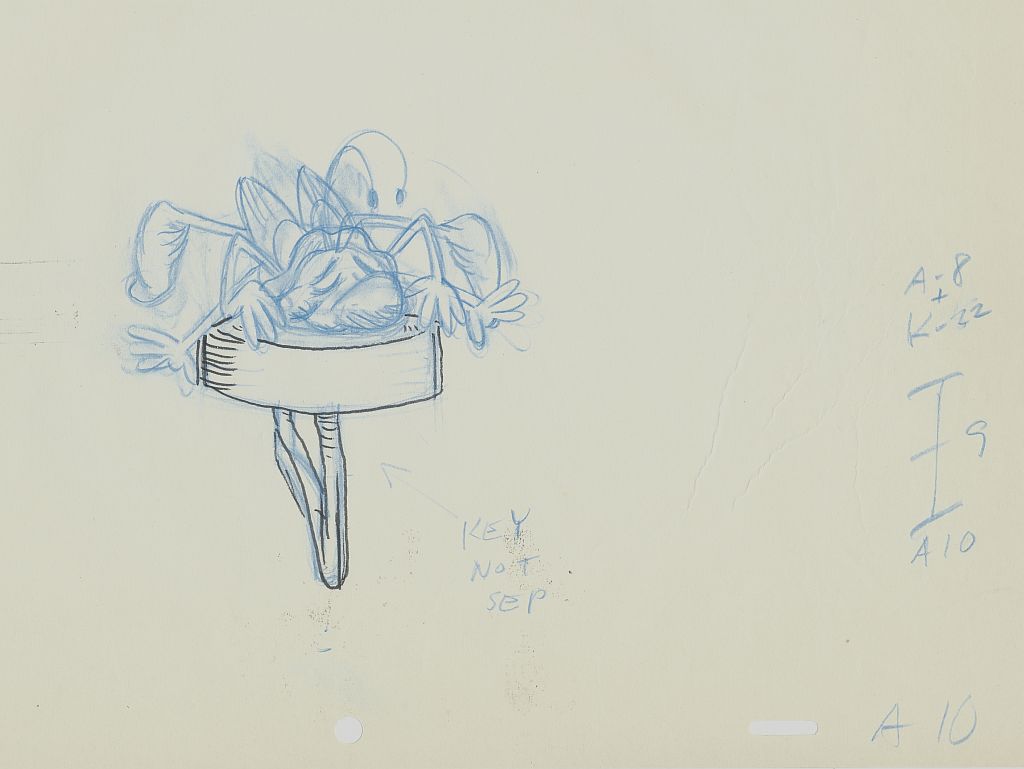  SHINNNBOHNNE ALLEEY! SHHINNNBOOOHOOONE ALLIEEE! (Imagine Allan Reed singing that.)
 SHINNNBOHNNE ALLEEY! SHHINNNBOOOHOOONE ALLIEEE! (Imagine Allan Reed singing that.)
Stripz
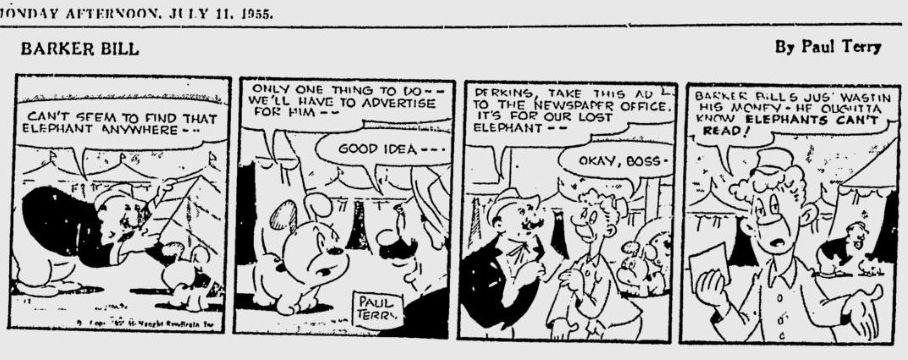






 Â At long last, it’s back to the strips! Here’s Barker Bill from 7-11 to 7-21-1955, courtesy of the Greensburg Daily Tribune. It’s lucky that the strip was mostly gags by this time, as the Greensburg Trib. only used four strips a week! Some of the regulars like Perkins, Col. Whetwhistle and Phyllis the strong lady are back. I’ve got enough strips for two more posts, then Barker Bill vanishes into comic strip oblivion.
 At long last, it’s back to the strips! Here’s Barker Bill from 7-11 to 7-21-1955, courtesy of the Greensburg Daily Tribune. It’s lucky that the strip was mostly gags by this time, as the Greensburg Trib. only used four strips a week! Some of the regulars like Perkins, Col. Whetwhistle and Phyllis the strong lady are back. I’ve got enough strips for two more posts, then Barker Bill vanishes into comic strip oblivion.





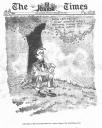





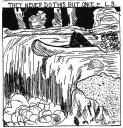





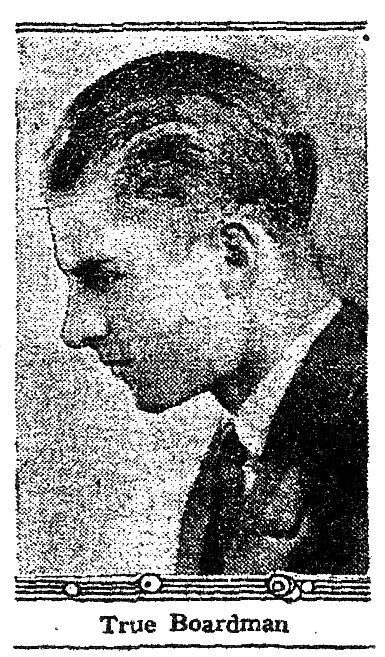  From the Los Angeles Junior Times in Oct. 1926, we have more “Fido Bark” strips by Bob Wickersham. He really kisses up to Aunt Dolly, but you will notice that she runs the strips out of order (the rule against continuity, you know), so buttering her up didn’t help. I. Ellis really worked hard and produced a couple of one shot strips, a ten dollar cover, and started a new strip called “Dunk Dank”. We also have strips by Lee Morehouse, who later became a top Donald Duck animator (“Hockey Champ”, “The Autograph Hound”), Phil DeLara, who became an animator for Bob McKimson at Warner Bros. in the 1940s and 1950s, “Louie” (Leo) Salkin, Manuel Moreno (another Keen and Feeble Tat, where the characters visit fellow Times cartoonist, Al Perez), a strip by Fred Moore and a portrait of True Boardman, who did some acting on stage in Aunt Dolly’s theatre parties and later became a great radio announcer (Chase and Sanborn Hour), radio actor (Famous Jury Trials), and wrote on the radio series “Lux Radio Theater”, “Silver Theater” and wrote on the cartoon series: “The Famous Adventures of Mr. Magoo”! I’ve also put in the first “Pit and Pat” strip by Eddie Schultz. I KNOW I’ve seen his credits on some animated cartoons, but can’t find the titles, any of you experts know about them?
 From the Los Angeles Junior Times in Oct. 1926, we have more “Fido Bark” strips by Bob Wickersham. He really kisses up to Aunt Dolly, but you will notice that she runs the strips out of order (the rule against continuity, you know), so buttering her up didn’t help. I. Ellis really worked hard and produced a couple of one shot strips, a ten dollar cover, and started a new strip called “Dunk Dank”. We also have strips by Lee Morehouse, who later became a top Donald Duck animator (“Hockey Champ”, “The Autograph Hound”), Phil DeLara, who became an animator for Bob McKimson at Warner Bros. in the 1940s and 1950s, “Louie” (Leo) Salkin, Manuel Moreno (another Keen and Feeble Tat, where the characters visit fellow Times cartoonist, Al Perez), a strip by Fred Moore and a portrait of True Boardman, who did some acting on stage in Aunt Dolly’s theatre parties and later became a great radio announcer (Chase and Sanborn Hour), radio actor (Famous Jury Trials), and wrote on the radio series “Lux Radio Theater”, “Silver Theater” and wrote on the cartoon series: “The Famous Adventures of Mr. Magoo”! I’ve also put in the first “Pit and Pat” strip by Eddie Schultz. I KNOW I’ve seen his credits on some animated cartoons, but can’t find the titles, any of you experts know about them?






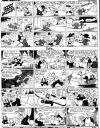 Â Felix, from 8-26 to 9-1-1935 continues Felix and Danny’s excavation of the ancient city. They find a newspaper column 5000 years old, and get caught in a cave-in! The Sunday (9-1) episode continues Felix’s adventures in Dreamland. He helps a poor clerk named Mr. Pluggin to survive a boring speech by his boss. I’ll bet Otto survived many a boring speech in his life by dreaming of Felix!
 Felix, from 8-26 to 9-1-1935 continues Felix and Danny’s excavation of the ancient city. They find a newspaper column 5000 years old, and get caught in a cave-in! The Sunday (9-1) episode continues Felix’s adventures in Dreamland. He helps a poor clerk named Mr. Pluggin to survive a boring speech by his boss. I’ll bet Otto survived many a boring speech in his life by dreaming of Felix!




 Â Ignatz is hiding in a long box in the Krazy strips from 7-7 to 7-12-1941. Offissa Pupp can’t stifle his curiosity about Ignatz’s hiding place and in the 7-12, he gives in to temptation. Note the elaborate stage decoration on the 7-12, as Garge fills the space with his unique designs. I’m sorry the strip for 7-11-41 is not here, do any of you great collectors have it?
 Ignatz is hiding in a long box in the Krazy strips from 7-7 to 7-12-1941. Offissa Pupp can’t stifle his curiosity about Ignatz’s hiding place and in the 7-12, he gives in to temptation. Note the elaborate stage decoration on the 7-12, as Garge fills the space with his unique designs. I’m sorry the strip for 7-11-41 is not here, do any of you great collectors have it?
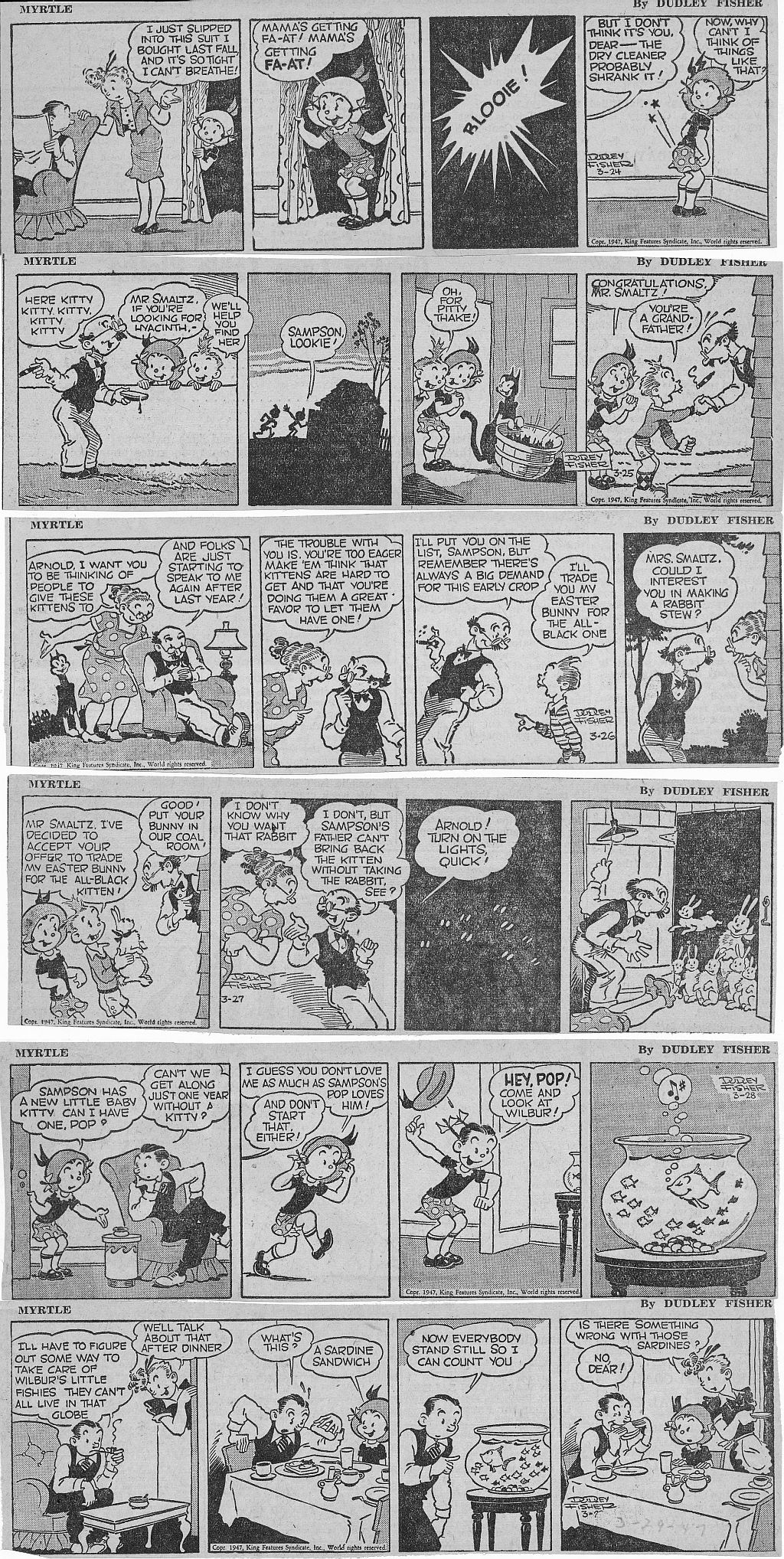 Â Myrtle this time from 3-24 to 3-29-1947 is full of springtime shenanigans! First Hyacinth has a litter of kittens, followed by Sampson’s Easter Bunny and then Mytle’s goldfish Wilbur has a bunch of guppies! It’s amusing to see how the fathers of the neighborhood deal with the animal and fish progeny. The 3-24 is a very endearing look at Myrtle’s sassy kid personality. She blurts right out at her Mother that she’s getting “FA-AT” and gets spanked AND has to stand in the corner. I love the last panel as she learns the meaning of “tact”. Well, this was another labor-intensive post, sure hope you enjoyed the “stripz”.
 Myrtle this time from 3-24 to 3-29-1947 is full of springtime shenanigans! First Hyacinth has a litter of kittens, followed by Sampson’s Easter Bunny and then Mytle’s goldfish Wilbur has a bunch of guppies! It’s amusing to see how the fathers of the neighborhood deal with the animal and fish progeny. The 3-24 is a very endearing look at Myrtle’s sassy kid personality. She blurts right out at her Mother that she’s getting “FA-AT” and gets spanked AND has to stand in the corner. I love the last panel as she learns the meaning of “tact”. Well, this was another labor-intensive post, sure hope you enjoyed the “stripz”.
Manon Puts Hal Ambro in Touch
As a continuing tribute to my friend Manon Washburn, here is the text of a letter from Harold (Hal) Ambro, Animator at Disney, Format, Hanna-Barbera and m0re. Manon did all the legwork to approach Hal on the job and ask him to write a letter to my Mother about my potential career in animation. He really came through and wrote quite a long letter, giving his opinions about the business, and about the kind of education he thought a young artist would need. Hal was a fellow St. Louisan, born there in 1913. He came to California in 1932 to study drawing, and wound up working for Charles Mintz on Scrappy and Color Rhapsodies, until he was employed by Walt Disney Productions in 1939. This letter was written about a year before he left Disney in 1966. After that he worked on many projects, such as “The Alvin Show” for Herb Klynn and many Hanna-Barbera projects, such as the feature “Heidi’s Song”, and some of the Scooby-Doo shows. I never got to know him well, said hello a few times. I saw him most often when he was working at the Sunset-Vine tower for Chuck Jones on “The White Seal”, “Mowgli’s Brothers” and “Rikki-Tikki-Tavi” in the 1970s.  Hal was a wonderful draftsman, as you can see by that appealing drawing of Wendy, above. He couldn’t really advance to “Nine Old Men” status at Disney, imagine the politics he had to navigate there to stay as long as he did! But like, Hal King, Bob Youngquist, Ken Hultgren and many other talents, he was a true Disney alumnus. Here’s the letter that maybe persuaded my Mother to think that animation wasn’t such a bad career choice after all:
Hal Ambro’s Letter to my Mother March 29 1965
Dear Mrs. Kausler,
It’s nice to hear about a young fellow who has decided what he wants to do. Animation as its used in Advertising Commercials will probably be around for a long time. The theatrical cartoon may someday cease to exist, due to high production costs.
Industrial and Educational films may replace the theatrical production, but here again cost is always important. Television may offer ways to help market animation features in the future.
As far as schooling goes, my opinion would be this; Training in layout, design, color, draftsmanship (figure and animal), Story ideas, would help to prepare one for a career in this field.
There are many ways to be a value in a small studio, and all the training you can get will be put to use, and you would be more valuable. The large Studio (Disney or Hannah(sic)-Barberra) still keep the work areas separated, i.e. animation dept., layout and background dept., Story dept., etc.
Any good art school that prepares you for advertising art would supply the necessary training. Chouinard is very fine school, Art Center in Los Angeles is an excellent Commercial Art and Industrial Design School. Chicago Art Institute I don’t know about, but undoubtedly is excellent.
The field of teaching, I think might offer some long range advantages. Teachers seem to have at least the prospect of good steady employment over the years. However I’m sure that in preparing for a teaching career in art, a student would necessarily have to study, if not produce the samples of fine arts. There is very little need for teachers in the animation industry.
Chouinard Institute has the qualified instructors as well as the University of So. California. So any teacher training would have to be in an academic art capacity and I’m sure there are many opportunities from the Elementary school level through the College level.
You asked about where I received my training. The only formal training I had was obtained at Art Center School in the early 1930 years. I went to night school and weekends to study figure drawing, composition. Even at that time the animation business was frowned upon by the Art Schools. The opportunities for a creative person, even now, may be far greater in possibly industrial design (designing of Automobiles, boats, packages, etc.) than the opportunities available in the animation field. And one thing I can vouch for, from 30 years of experience, is that the animation industry at the present time and for the past 5 years or so, has not been a growing business.
Regardless of the allure that surrounds the Disney Studio’s, their animation product is gradually diminishing in volume. The work force needed to-day at Disney’s to produce animation product is about 25% of what it used to be. This doesn’t mean that the artist can’t find a job there, but it does show that there are not many jobs available. This also means that the Studio can be very discriminating about the quality of the artist to-day and therefore it’s tougher to qualify. However, there are a few other studios (Playhouse and H-B notably). Playhouse, by the way, has had a practice of hiring the Animator on a free-lance basis. That means only when they have work, do they hire an animator. There is another aspect of this business that might present some possibilities, the ability to think up ideas for commercials and be able to present them in a graphic manner. By that I mean, draw up what I’ll call a story board and show just what the commercial will look like when its finished.
Actually, the ideas are the most important part of the commercial, so if Mark has a flair for ideas, he might find a spot in some Ad agency.
Educational T.V. may develop into a large field some day, but it hasn’t been exploited much up ‘til now. The cartoon industry in T.V. is limited to simple animations. The cost of productions and the time consumed in making a picture has put limitations on the T.V. cartoon product. As an example, “Rocky and his friends” (a T.V. weekly show of cartoons) (similar to Yogi Bear of H. & B. fame) is actually conceived and planned here, but animated and finished in Mexico City. And then after productions of any sort are finished, the producer re-sells the product 2 or 3 times. The H-B studio besides Disney is the only one that really keeps operating on a large scale, but even they are re-using material. I have worked on the “Alvin Show”, a cartoon show about 3 chipmunks, about 4 years ago. The “Alvin Show” is still being re-run. The T.V. networks buy these packages of pictures and keep selling them to advertising clients. Its smart business for the networks, but unfortunate for the cartoonists. This is why I personally feel that animated commercials, with all the ideas, story-boards, layout needs, and possible use of color, present the biggest opportunity to-day. This does not mean that opportunity is not in the theatrical cartoon, but I feel that advertising offers more. Even so the training one needs is the same for both fields.
If Mark has already been working with a commercial studio this is fine. He might find a valuable spot with that studio. He’s certainly getting a young start.
Well, I hope I have not thoroughly confused you with these thoughts on the business and as far as schooling goes, I really can’t say what is best. I know that to-day the versatility of one is important, so I feel that a well-rounded background of ideas, story-sketch ability, draftsmanship, layout or design, color, are equally needed.
Good luck in all your efforts, Mark and keep studying
Sincerely, Harold Ambro
Notably, Hal comments on the Disney studio’s decreasing volume of animation by 1965, and his hopes for the use of animation for education. It’s interesting that the prospects for employment in 1965 were so limited. Hal also makes a profound statement about TV series work when he says that the network’s ability to sell the same shows two or three times was “unfortunate for the cartoonists”. This was very true, especially when you consider that no cartoonist was paid any TV residuals, and had to be content with his hourly or piecework rate for the TV series work done. Both Manon and Hal were very hopeful about the use of animation for educational purposes. Of course, the reality of the situation was that most educational animated films were produced for a low price. Hugh Harman dabbled in them, but couldn’t produce much more that pose reels. Coronet films, Wilding Films and a few other companies made quite a few educational pictures, many of them being distributed on 16mm for schools and free loans, such as the Bell System Science Series, perhaps the best achievement in educational animation to date. That educational market has almost disappeared now for traditional animation, replaced by digital “animation”, such as Dr. Oz currently uses to show feces trapped in a colon (that’s entertainment)!
Hal became a teacher at Cal Arts in 1982, and passed away at his home in Woodland Hills in 1990.










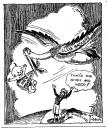
 Â We explore the L.A. Jr. Times from Sept. 1926 this time. It’s another tribute to Bob Wickersham and his funny animal strip “Fido Bark” from 9-5 to 9-26. There’s also a photo of Bob and Fido, and a strip by Bob’s friend Alex Perez about a visit to Bob’s house. Alex falls in love with Bob’s sister at first sight and tries to romance her through his comic strip! There’s also a Bill Zaboly cartoon about how a cartoonist submits work to the T.J.C.; Bill steals a bit from Clare Briggs here as he quotes “Ain’t It A Graaanndd and Glorious Feeeling!” There’s also a caricature of Manuel Moreno, an editorial cartoon by Frank Tipper and a comic strip by Larry Martin called “Billie Jean”, which he drew on 8-6-26.
 We explore the L.A. Jr. Times from Sept. 1926 this time. It’s another tribute to Bob Wickersham and his funny animal strip “Fido Bark” from 9-5 to 9-26. There’s also a photo of Bob and Fido, and a strip by Bob’s friend Alex Perez about a visit to Bob’s house. Alex falls in love with Bob’s sister at first sight and tries to romance her through his comic strip! There’s also a Bill Zaboly cartoon about how a cartoonist submits work to the T.J.C.; Bill steals a bit from Clare Briggs here as he quotes “Ain’t It A Graaanndd and Glorious Feeeling!” There’s also a caricature of Manuel Moreno, an editorial cartoon by Frank Tipper and a comic strip by Larry Martin called “Billie Jean”, which he drew on 8-6-26.







  Barker Bill this time consists of mostly “hat raising” spot gags that ran from 6-27 to 7-8-55. The 7-8 seems to be out of order, but I can’t read the date! It seems to be from the earlier stories about the Gelt. Little May is the subject of two strips this time.
 Barker Bill this time consists of mostly “hat raising” spot gags that ran from 6-27 to 7-8-55. The 7-8 seems to be out of order, but I can’t read the date! It seems to be from the earlier stories about the Gelt. Little May is the subject of two strips this time.






  Felix, from 8-19 to 8-25-1935, continues Felix’s exploration of the 5000 year old city he found on the Ape’s Island. He discovers a petrified bulldog and an ancient blow-gun. One of the sailors in the 8-23 is assigned to be a letter carrier back to the ship. What he anticipates to be an easy job is a hard haul because the letter is chiseled in 5000 year old stone! This gag anticipates the Fleischer “Stone Age” cartoons and of course, “The Flintstones” TV show. In the Sunday page, the little blond kid in the Bobby Dazzler topper resembles “Vontzy” from the Scrappy cartoons quite closely, in the main strip, Felix (still in Dreamland) helps a cop apprehend some burglars while he’s still asleep.
 Felix, from 8-19 to 8-25-1935, continues Felix’s exploration of the 5000 year old city he found on the Ape’s Island. He discovers a petrified bulldog and an ancient blow-gun. One of the sailors in the 8-23 is assigned to be a letter carrier back to the ship. What he anticipates to be an easy job is a hard haul because the letter is chiseled in 5000 year old stone! This gag anticipates the Fleischer “Stone Age” cartoons and of course, “The Flintstones” TV show. In the Sunday page, the little blond kid in the Bobby Dazzler topper resembles “Vontzy” from the Scrappy cartoons quite closely, in the main strip, Felix (still in Dreamland) helps a cop apprehend some burglars while he’s still asleep.





 Â Krazy, from 6-30 to 7-5-1941 is a six-part story about “blondeness”. You see, Krazy Kat gets her hair lightened in the Coconino Beauty Parlor, which causes a chain reaction of mistaken identity gags. In the 7-5, a little porter comes out of the Beauty Parlor with a blonde brick!
 Krazy, from 6-30 to 7-5-1941 is a six-part story about “blondeness”. You see, Krazy Kat gets her hair lightened in the Coconino Beauty Parlor, which causes a chain reaction of mistaken identity gags. In the 7-5, a little porter comes out of the Beauty Parlor with a blonde brick!
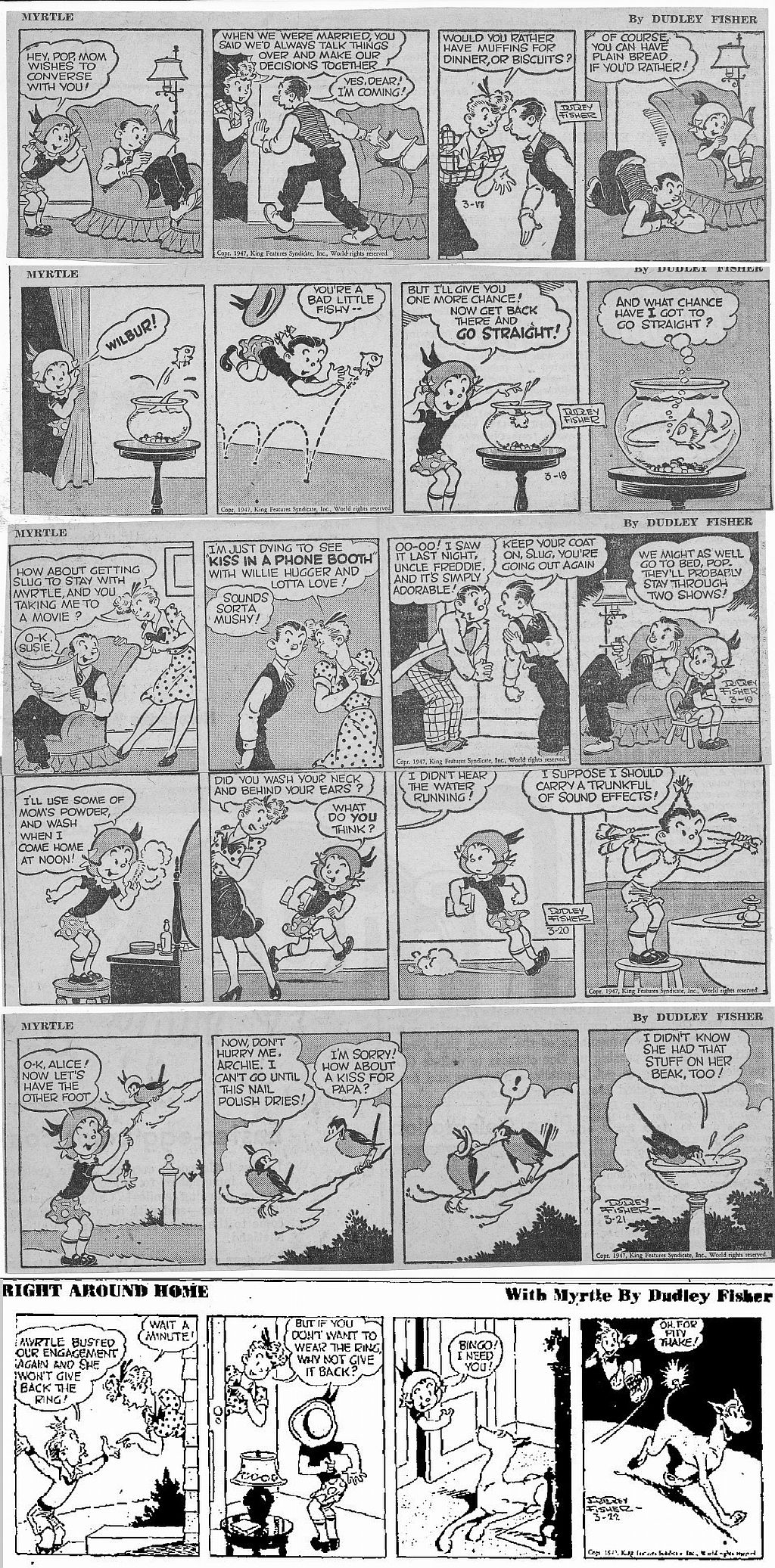 Â Dudley Fisher’s Myrtle this time is from 3-17 to 3-22-1947. I thought that Slug’s dialog in the third panel of the 3-19 was a real hoot, if you imagine him talking like Joe Besser. In the 3-20, there is a bit of a radio reference (radio drama was still big in 1947) as Myrtle says “I suppose I should carry a trunkful of sound effects!” In the 3-22 I like Sampson’s reaction to his ring winding up on Bingo’s tail, as he flys through the air in a big “take”.
 Dudley Fisher’s Myrtle this time is from 3-17 to 3-22-1947. I thought that Slug’s dialog in the third panel of the 3-19 was a real hoot, if you imagine him talking like Joe Besser. In the 3-20, there is a bit of a radio reference (radio drama was still big in 1947) as Myrtle says “I suppose I should carry a trunkful of sound effects!” In the 3-22 I like Sampson’s reaction to his ring winding up on Bingo’s tail, as he flys through the air in a big “take”.

 Â In anticipation of Yowp’s monthly dose of Yogi Bear Sunday pages, here are all the strips I have from July, 1962. They are from 7-22 and 7-29 respectively, the 7-22 might be the work of Gene Hazelton, note how Yogi keeps calling Boo-Boo, “Boo” throughout the strip. The 7-29 gag looks like Harvey Eisenberg’s work, especially the lettering on the mailbox and the Ranger’s sign, as well as the use of silhouette in the second panel. I know I’ve seen that “bees in the filing cabinet” joke before, but can’t remember where. Do any of you faithful readers recognize it?
 In anticipation of Yowp’s monthly dose of Yogi Bear Sunday pages, here are all the strips I have from July, 1962. They are from 7-22 and 7-29 respectively, the 7-22 might be the work of Gene Hazelton, note how Yogi keeps calling Boo-Boo, “Boo” throughout the strip. The 7-29 gag looks like Harvey Eisenberg’s work, especially the lettering on the mailbox and the Ranger’s sign, as well as the use of silhouette in the second panel. I know I’ve seen that “bees in the filing cabinet” joke before, but can’t remember where. Do any of you faithful readers recognize it?
And So Manon, Goodbye
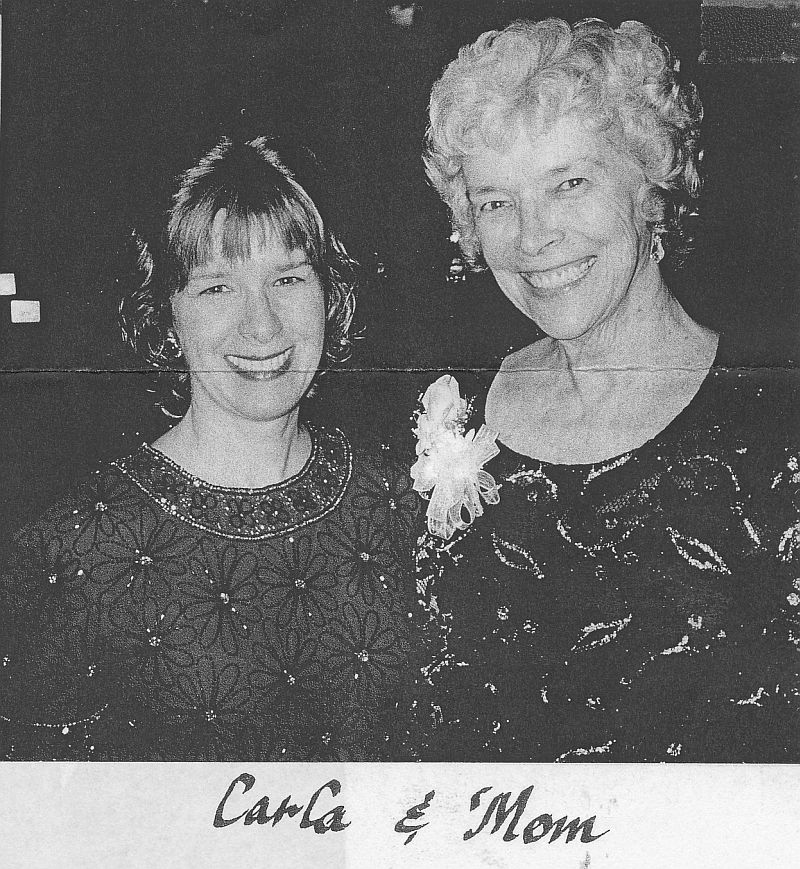 I learned Sunday Morning, June 24ththat my friend and mentor Manon Washburn had passed away as the result of a stroke the previous week (June 21st). Manon’s daughter Carla told me the news, above is a recent picture of Mother and Daughter from 2010.
I learned Sunday Morning, June 24ththat my friend and mentor Manon Washburn had passed away as the result of a stroke the previous week (June 21st). Manon’s daughter Carla told me the news, above is a recent picture of Mother and Daughter from 2010.
(In honor of Manon, no comics this post, all the cartoons are illustrations for the article. I have preserved most of Manon’s spelling and punctuation in the excerpts from her letters. Remember to click on the thumbnails to enlarge the pictures.)
You see, Manon was a very special childhood heroine of mine. Her first husband, Everett Washburn was a sheet metal worker who was employed at Curtis-Wright aircraft in California with my Dad Albert in the 1930s. Dad thought a great deal of Everett, they were good friends, and Everett told my dad that his wife was an inker in the animated cartoon business. I wrote to her, telling her of my great love for cartoons and desire to get into the business. Amazingly, she was not discouraging, but decidedly upbeat about it, a great contrast to my Mother’s attitude toward cartoons. We exchanged letters often, and she sent me many inked cels from commercials and TV shows she was working on, this was 1963 to 1967. She went out of her way to find animation artwork for me: Manon writing on March 12, 1964: I am really thrilled with one thing I am sending and am so very lucky to have gotten it. It is a complete story-board layout of one of the half-hour Flintstone shows. (TS-132 “Ladies Night Out At The Lodge”P-109) You yourself are really responsible for my getting it. You see, I have patiently approached one animator after another with your letter and begged for a crumb from their board. Some, as you know, are too busy to take much interest, others are pleased at your interest but don’t come up with anything—-and then there’s that one in a million who really knocks himself out because he has the capacity to appreciate what you are doing. This one I am talking about is an animator, a marvelous one, named Willie Ito (pronounced EETO). He is of Japanese descent I think but a real “way out kid” and what an artist! Well, anyhow, I told Willie about you (he works at Hanna-Barbera) and gave him your letter to read at his leasuire. He was charming and appeared both interested and impressed but I wasn’t sure about it until he handed me a huge folder full of loot!! He enclosed all kinds of production pictures beside the layout but told me he was sure you would get the most out of it because all the camera instructions are given on it and you would see all the terms that they use and how they indicate various things. I went through it carefully and was tempted to interpret such things as FX which means effects (sound, usually) but decided against it because I’m pretty sure you will understand it all without my help. I feel that you have enough background in animation to figure it out without difficulty. Of course, it goes without saying, that someone without your knowledge would not get the camera moves indicated and other strictly animation terms. (Among the drawings were several from the Magilla Gorilla Show main titles)
You yourself are really responsible for my getting it. You see, I have patiently approached one animator after another with your letter and begged for a crumb from their board. Some, as you know, are too busy to take much interest, others are pleased at your interest but don’t come up with anything—-and then there’s that one in a million who really knocks himself out because he has the capacity to appreciate what you are doing. This one I am talking about is an animator, a marvelous one, named Willie Ito (pronounced EETO). He is of Japanese descent I think but a real “way out kid” and what an artist! Well, anyhow, I told Willie about you (he works at Hanna-Barbera) and gave him your letter to read at his leasuire. He was charming and appeared both interested and impressed but I wasn’t sure about it until he handed me a huge folder full of loot!! He enclosed all kinds of production pictures beside the layout but told me he was sure you would get the most out of it because all the camera instructions are given on it and you would see all the terms that they use and how they indicate various things. I went through it carefully and was tempted to interpret such things as FX which means effects (sound, usually) but decided against it because I’m pretty sure you will understand it all without my help. I feel that you have enough background in animation to figure it out without difficulty. Of course, it goes without saying, that someone without your knowledge would not get the camera moves indicated and other strictly animation terms. (Among the drawings were several from the Magilla Gorilla Show main titles) 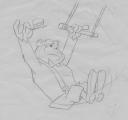 Do let me know if you are as pleased with it as I was. If you saw this particular Flintstone show, it will have even more meaning than otherwise. I always admired her ability with pen and brush on the unforgiving plastic ice pond known as a cel. She had such a delicate, supple fine line. Look at these examples from a Navy Recruiting spot produced at Playhouse Pictures.
Do let me know if you are as pleased with it as I was. If you saw this particular Flintstone show, it will have even more meaning than otherwise. I always admired her ability with pen and brush on the unforgiving plastic ice pond known as a cel. She had such a delicate, supple fine line. Look at these examples from a Navy Recruiting spot produced at Playhouse Pictures. 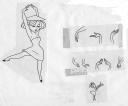 I especially like the hands and the cel with the tiny girl: On a visit to her house in 1963, she showed me several old cels from Leon Schlesinger cartoons of 1943. I remember she had one of Bugs Bunny, an early Elmer Fudd, and several others, all in that amazing fine line. She worked on “Hell-Bent For Election” at the fledgling UPA in 1944 when it was Industrial Film and Poster Service. This pro-Roosevelt film was right in line with her politics at the time. Manon worked on this picture with Martha Sigall, famed Schlesinger inker. Manon writing in 1964: It interested me very much when you said that the “great classics and animation were meant for each other”. I have always felt very strongly that as an educational medium, animation would have no equal. During the war (WWII), I worked on training films for the Army Air Force and I have never been able to forget the wonderful way animation can teach. (This was when Manon was with the First Motion Picture Unit in 1943. She’s to the extreme right of the photo-not politically.)
I especially like the hands and the cel with the tiny girl: On a visit to her house in 1963, she showed me several old cels from Leon Schlesinger cartoons of 1943. I remember she had one of Bugs Bunny, an early Elmer Fudd, and several others, all in that amazing fine line. She worked on “Hell-Bent For Election” at the fledgling UPA in 1944 when it was Industrial Film and Poster Service. This pro-Roosevelt film was right in line with her politics at the time. Manon worked on this picture with Martha Sigall, famed Schlesinger inker. Manon writing in 1964: It interested me very much when you said that the “great classics and animation were meant for each other”. I have always felt very strongly that as an educational medium, animation would have no equal. During the war (WWII), I worked on training films for the Army Air Force and I have never been able to forget the wonderful way animation can teach. (This was when Manon was with the First Motion Picture Unit in 1943. She’s to the extreme right of the photo-not politically.) A year or so ago, there was an hour long animated story on the sun on T.V. (“Our Mr. Sun”) It may have been made for a science class. It was expertly done and the (sometimes) dull scientific facts about the sun, its energy and what relation and effect it has on our lives was never more interestingly given. Here’s a few words about animation that Manon wrote in 1962, together with a wage breakdown for animation workers of the day:
A year or so ago, there was an hour long animated story on the sun on T.V. (“Our Mr. Sun”) It may have been made for a science class. It was expertly done and the (sometimes) dull scientific facts about the sun, its energy and what relation and effect it has on our lives was never more interestingly given. Here’s a few words about animation that Manon wrote in 1962, together with a wage breakdown for animation workers of the day:
One of the most intriguing things about animation is the liberty the animator has in interpreting a character (such as Walt Disney did with Mickey Mouse).I work on all the Burgie Beer commercials–he’s a very stylized little man. There’s a tremendous latitude between a drawing that almost is human and one that’s vastly simplified such as the Folger Coffee bean. I see no harm in Mark concentrating on what interests him most, that is animating a figure. There will always be artists who are only interested in drawing backgrounds. Most of the top people in the animation field have had four years of art school—not as many have had college art training because it usually isn’t as good. U.C.L.A. is, and there he would get the well-rounded education that is necessary in almost every intelligent field today. The top animators become storyboard layout men and for that you need a comprehensive education, psychology, philosophy, history, etc.
I see no harm in Mark concentrating on what interests him most, that is animating a figure. There will always be artists who are only interested in drawing backgrounds. Most of the top people in the animation field have had four years of art school—not as many have had college art training because it usually isn’t as good. U.C.L.A. is, and there he would get the well-rounded education that is necessary in almost every intelligent field today. The top animators become storyboard layout men and for that you need a comprehensive education, psychology, philosophy, history, etc.
The animation field is not too crowded. Highest in demand are the story-board and layout men. Each studio has only a few. Their weekly check is in the neighborhood of $500 a week. The top animators and background artists get between $250 (min.) and $450–etc. Assistant animators (just off the art school assembly line–) begin at $200 a week. Anim. Checkers make $150. Inkers, like myself, make $105. (take home $86) and painters make $90.
Despite the relatively low wages she earned, Manon was a hard worker and often took on two or three jobs at the same time to earn extra money.
Manon writing in August 1967: The Cartoon industry is still flourishing out here! Inkers are still at a premium. For almost two years now. I have been able to make more than a fourty hour check by simply taking work from more than one studio. Everything is still on the up-swing. New contracts and commercials, new animated series are all still very much with us. After I finished Charlie Brown All Stars for Bill Melendez, I went to work for Grant-Ray Lawrence who are putting out a series called Marvel Super Hero’s and out here it is on Sun. eves at 6pm for half an hour. It is limited animation and inking is just a matter of mouths, eyes, arms moving and loads of special effects! (guns blasting-rays-explosions, bullets conecting-etc.–it’s wild!)
Just last week, I also got some work from my favorite employer, Mary Cain, who you met. Disney is so busy with live action and other things–that he farmed out a commercial to Mary—So at last! I can say I have worked for Disney! I was careful to ink several of the cutest characters for you and I will paint them up and send them along! And you can say that Disney had to get his old animators to draw them, as the youngsters didn’t know how! It’s the real thing! Revived!
She did this overtime and free-lance practically all through her working life. Here, Manon gave me an idea of just how busy she could get: …my studio kept me very busy all through December. You should see me inking at my desk while the (neighbor’s) children build with the blocks on the rug beside me. If one knocks the other over the head with a block, Cathy (Manon’s daughter) dashes in to referee while I glance over occasionally to make sure blood isn’t flowing freely yet! As you can see from these sample cels, Manon could work with a wide variety of line styles, thick, thin, brush, pen or grease pencil.



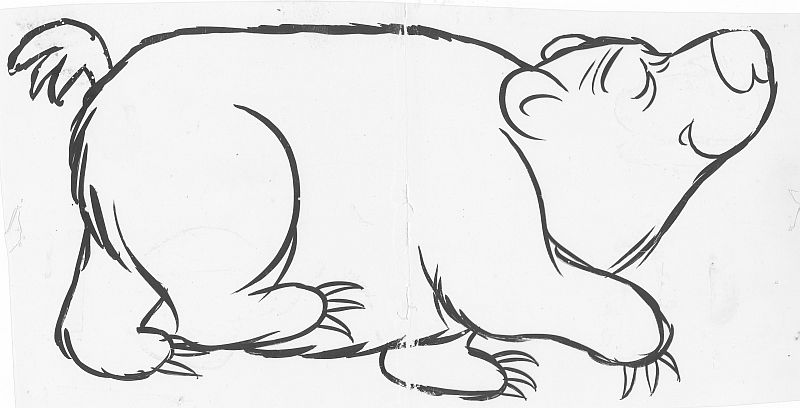 In 1966, Manon sent me a number of long Cinerama sized cels from the title sequence to “It’s a Mad, Mad, Mad, Mad World” which she traced onto the slippery plastic slopes with a grease pencil:
In 1966, Manon sent me a number of long Cinerama sized cels from the title sequence to “It’s a Mad, Mad, Mad, Mad World” which she traced onto the slippery plastic slopes with a grease pencil:
….I am sending some long cels in hopes you can cut them to size. They were rejections on “Mad, Mad World” because of scratches. I don’t think scratches show up on ordinary pictures, it was just that each cel was blown up ten feet and every speck of dust came through on the film. Also, I am sending some actual rejected sequences on “Mad World”. This is somewhat against my better judgement because you may find it worthless. I had to do the scene completely over because of scratches and I thought that either you would be interested in seeing the animation or that you could wash the cels off and re-use them. Let me know later on if you found any use for them. I’m still using them, Manon:

I visited the Washburns on my own in the summer of 1968, on vacation from Art School in Kansas City, intending to stay for two weeks. By the time I got out to Los Angeles, Everett and Manon were no longer married, but Everett lived about four blocks away from where Manon lived in Tujunga, so he put me up in a shed at the back of his house. I’ll never forget the first few nights I tried to sleep out there, so excited about cartoons and being so near to where they are made that I couldn’t close my eyes! While staying at Everett’s house, he taught me about Karl Marx and especially Marx’s predecessor, Georg Hegel. Everett was quite a serious, scholarly man who had very deep political beliefs. I got the feeling that Manon and Everett might have been attracted to each other partially from their political sensibilities. Manon could be a firebrand, being quite a critic of the war in Vietnam. She was in great favor of peace, we had quite a few discussions about that.
Manon made it possible for me to have a job, then a career in animated cartooning! She introduced me to Gary Mooney, who was animating a Green Giant commercial at Quartet Studio. He let me do a few inbetweens of the elves in the spot. They were no great beauties, but they were inkable. Here’s one of Gary’s roughs from that spot: I took the drawings into Filmation as samples; Hal Sutherland looked them over and said two words: “Start Monday”. I couldn’t drive, so I learned the bus route from Tujunga (where Manon lived) to Sherman Way in Reseda where Filmation was. I was in cartoon heaven working there, and met many old timers like Ruben Timmens and Virgil Ross. At last I wore out my welcome at Everett’s house (didn’t know enough about Hegel), and wound up bunking in the editing room of Fred Calvert’s studio in North Hollywood, which was a shorter bus ride to Filmation. I found myself working days at Filmation and nights at Fred Calvert’s, to earn my room. I would have worked 24 hours a day if I hadn’t needed sleep, I was just so excited to be doing professional work! I met Duane Crowther at Calvert’s, who became another mentor and great friend to me. All this happened because Manon introduced me to Gary Mooney.
I took the drawings into Filmation as samples; Hal Sutherland looked them over and said two words: “Start Monday”. I couldn’t drive, so I learned the bus route from Tujunga (where Manon lived) to Sherman Way in Reseda where Filmation was. I was in cartoon heaven working there, and met many old timers like Ruben Timmens and Virgil Ross. At last I wore out my welcome at Everett’s house (didn’t know enough about Hegel), and wound up bunking in the editing room of Fred Calvert’s studio in North Hollywood, which was a shorter bus ride to Filmation. I found myself working days at Filmation and nights at Fred Calvert’s, to earn my room. I would have worked 24 hours a day if I hadn’t needed sleep, I was just so excited to be doing professional work! I met Duane Crowther at Calvert’s, who became another mentor and great friend to me. All this happened because Manon introduced me to Gary Mooney.
I remember getting a lot of life lessons from Manon. I was pretty annoying and geeky when I got out to Los Angeles, (still am occasionally) and talked about cartoons almost all the time. Manon put up with it for quite awhile, but she eventually lost patience with my cartoon yammering. She let me know that even though she had been in the business since 1943, she didn’t really care for cartoons all that much. She was an artist, that happened to have the skill to work as an inker. She enjoyed the work to an extent, but it wasn’t a calling. (Later on, Manon taught watercolor painting, just look at her flowers and landscapes.) 
 I don’t think Manon ever told me exactly how she got started in the business, she was probably close to 21 when she started working. She also taught me to respect her as a lady, to open doors for her, and treat her gently. Not that I was rough on her, but I guess I thought of Manon as a fellow cartoon geek. I got wised up eventually.
I don’t think Manon ever told me exactly how she got started in the business, she was probably close to 21 when she started working. She also taught me to respect her as a lady, to open doors for her, and treat her gently. Not that I was rough on her, but I guess I thought of Manon as a fellow cartoon geek. I got wised up eventually.
Some years later, about 1972, I picked up a job from my friend Joe Adamson. He needed an animator to do a few scenes of Bugs Bunny for his independent short film, “A Political Cartoon”. I actually got a few lessons on how to draw Bugs from his best designer, Bob McKimson. When the drawings were finished, I immediately thought of Manon, who agreed to ink them. What a thrill to have an actual Warner Bros. inker doing my rabbits! I paid her as well as I could, and wound up with no money for the background painter, so I did them myself. I tried to save money on paint by using an old jar of Cartoon Colour rewettable white paint, which cracked and chipped in only a few years. This made the cels actually look much older than they actually were. That and Manon’s artistry made them more saleable as collectibles later on.
One of Manon’s good friends at Bill Melendez Studio was Bernard Gruver, a key layout and story board artist. Bernard thought the world of Manon, and often told me that her life stood for love, and she had a loving attitude to just about everybody. Here’s a birthday card that Bernard drew for Manon:
Manon writing on May 15, 1966: Now about things here in Hollywood. Bill Melendez broke with Playhouse Pix and went into business for himself. No, I did not work on the Charlie Brown Christmas Show, but I did see it. And I have worked on the new baseball show which has just gone to camera. It is called “Charlie Brown All Stars”, its about baseball and airs on June 8th. Please see it in color, if you can, you can’t really appreciate it in black and white. (1/2 hour show -full animation)
You will notice that the smaller studios (like Bill’s) always use inkers because on a small production the quality is more noticeable and more important. (An inker can interpret a character and impart a certain flavor.) The big studios are the only ones using Xerox that I know of–Disney–to be specific. Hanna Barbera are using a sort of grease pencil which goes faster than pen and is adequate for their multiple productions. I have worked on some Xerox for some pretty terrible (my opinion) low budget stuff. Inkers have to repair and register all Xerox. Without exception, all the commercials and shows which I have worked on have been inked. This year everything I have done has been in color. Animation comes across beautifully on color television and so much is being done in color now. Personally, I feel more full of hope than ever for animation and its marvelous possibilities for education, in spite of the poor material that has used this (our) medium thus far. I can’t help believing that not only will someone come along and do marvelous, top quality things in animation, but, that as a medium for education it will be fully utilized. Just because Disney has done so much with animation doesn’t mean he has exhausted the possibilities. (It’s interesting that color television was still such a remarkable novelty in 1966.)
Work is plentiful this year and the future looks bright.
Here are a few words that Manon wrote about the automation of the inking process (Xerox) which still ring true in the computer era: I fully agree with all you said on automation. In some places Xerox is replacing inkers but I cannot possibly imagine how it could replace animators. When that day comes and individual creative effort is eliminated it will be a sad commentary on the human race. Let’s have faith that we will never do that to ourselves. I do think that in many places in the world, people are not as barbaric as they used to be. But our scientific development is still way ahead of our social development. The great animator Grim Natwick came to nearly the same conclusion about scientific and social development when he was thinking about computer animation and electronic gadgets years later.
I had the great honor to speak for Manon in 2005, when she got her Golden Award for a lifetime in animation. Manon’s family, my wife Cathy and I were all there around her table at the Golden Awards banquet.  It was such a great night. It was an honor to see one of the good people, the inkers who never got enough credit for making animation drawings look good on the screen, receive this honor from her peers.
In her last years, I saw Manon less frequently. Her family expanded and she became a great-grandmother. Just look at that happy face with her grand-child Cove in 2011. That’s the way I like to remember Manon, that beaming happiness. All her children have that warm smile, it’s a family trademark. Her son, Conrad certainly has the family smile:
That’s the way I like to remember Manon, that beaming happiness. All her children have that warm smile, it’s a family trademark. Her son, Conrad certainly has the family smile:  I learned to respect Manon’s look of seriousness too, it meant she was thinking, and most of her thoughts were worth listening to. Her voice was breathy when she talked, almost a Marilyn Monroe inflection, but not as caricatured. She made friends easily, and never forgot a friend. Manon, I hope you will never be forgotten by your friends. Carla tells me that her Mom was alert, happy, teaching watercolor, dancing and active right up to the very end. Thanks, dear lady for all that you did for me. And so, Manon, Goodbye.
I learned to respect Manon’s look of seriousness too, it meant she was thinking, and most of her thoughts were worth listening to. Her voice was breathy when she talked, almost a Marilyn Monroe inflection, but not as caricatured. She made friends easily, and never forgot a friend. Manon, I hope you will never be forgotten by your friends. Carla tells me that her Mom was alert, happy, teaching watercolor, dancing and active right up to the very end. Thanks, dear lady for all that you did for me. And so, Manon, Goodbye.
(Any comments on Manon would be welcomed by her family. You can reach them at: yiayia.washburn@gmail.com . You are also welcome to comment here.)
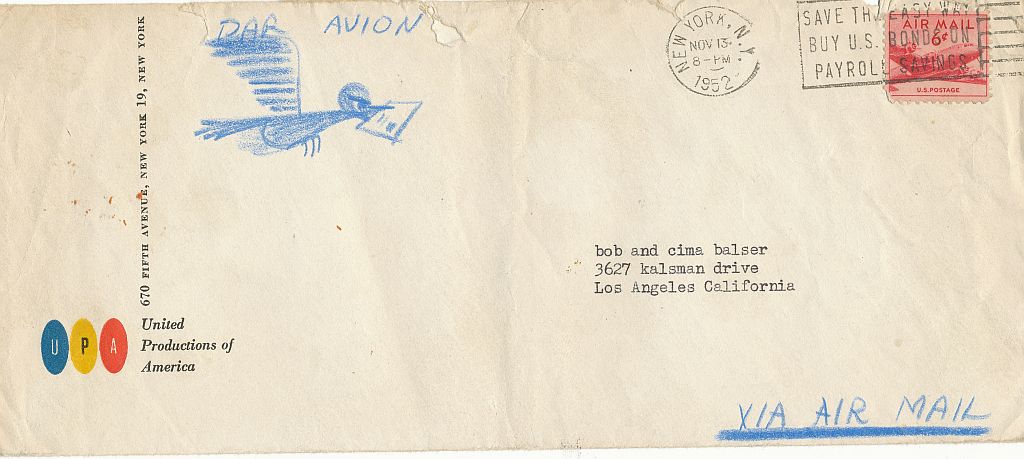

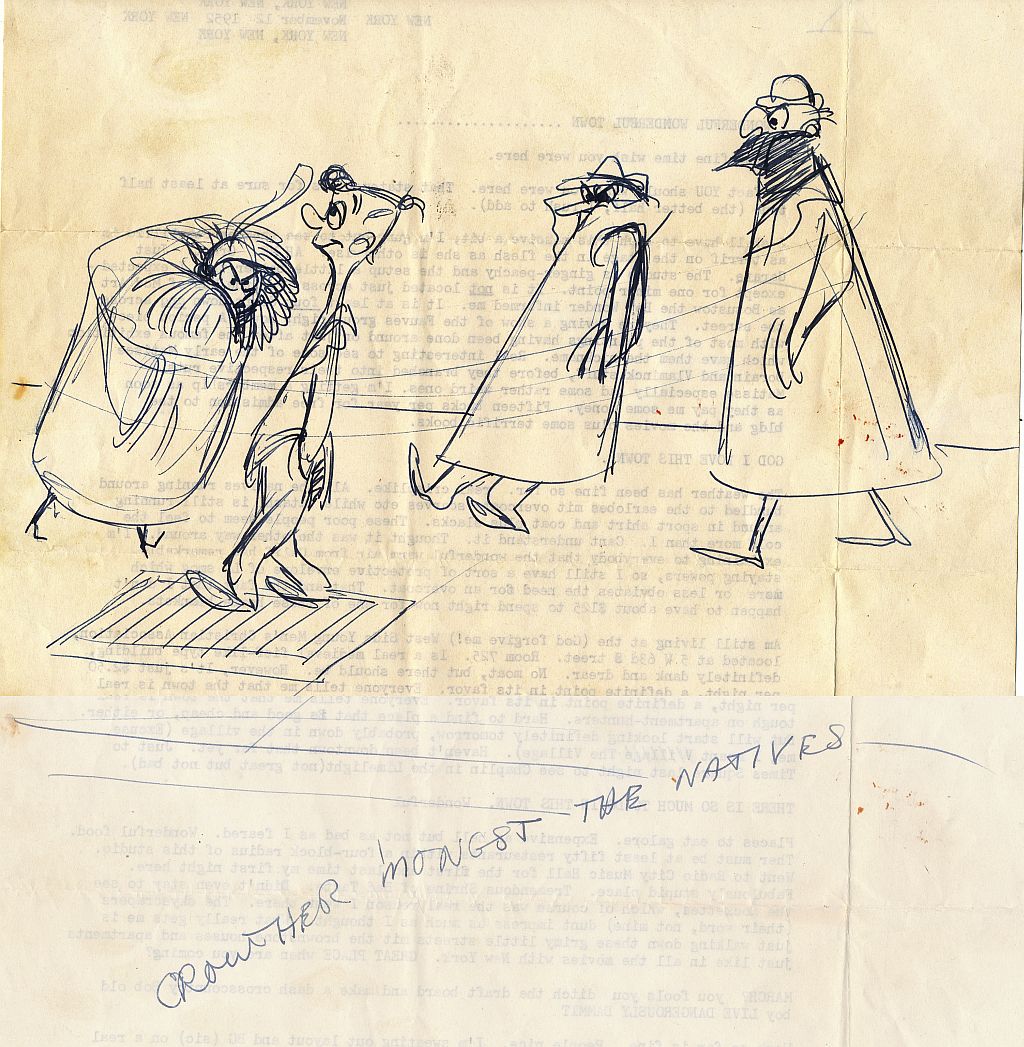
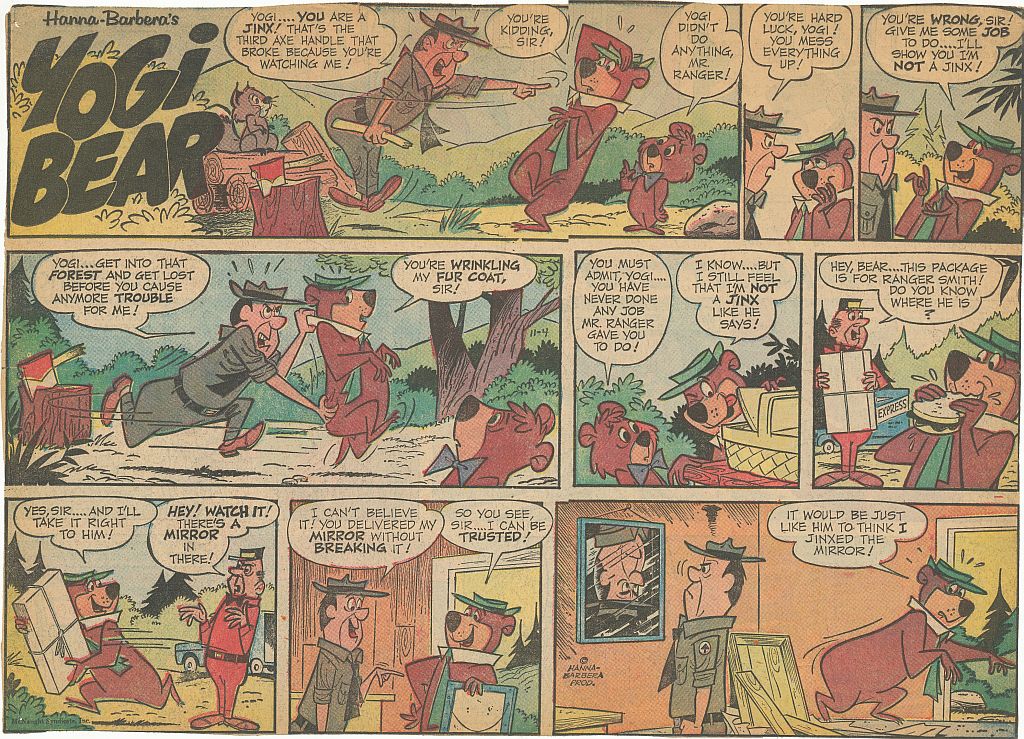
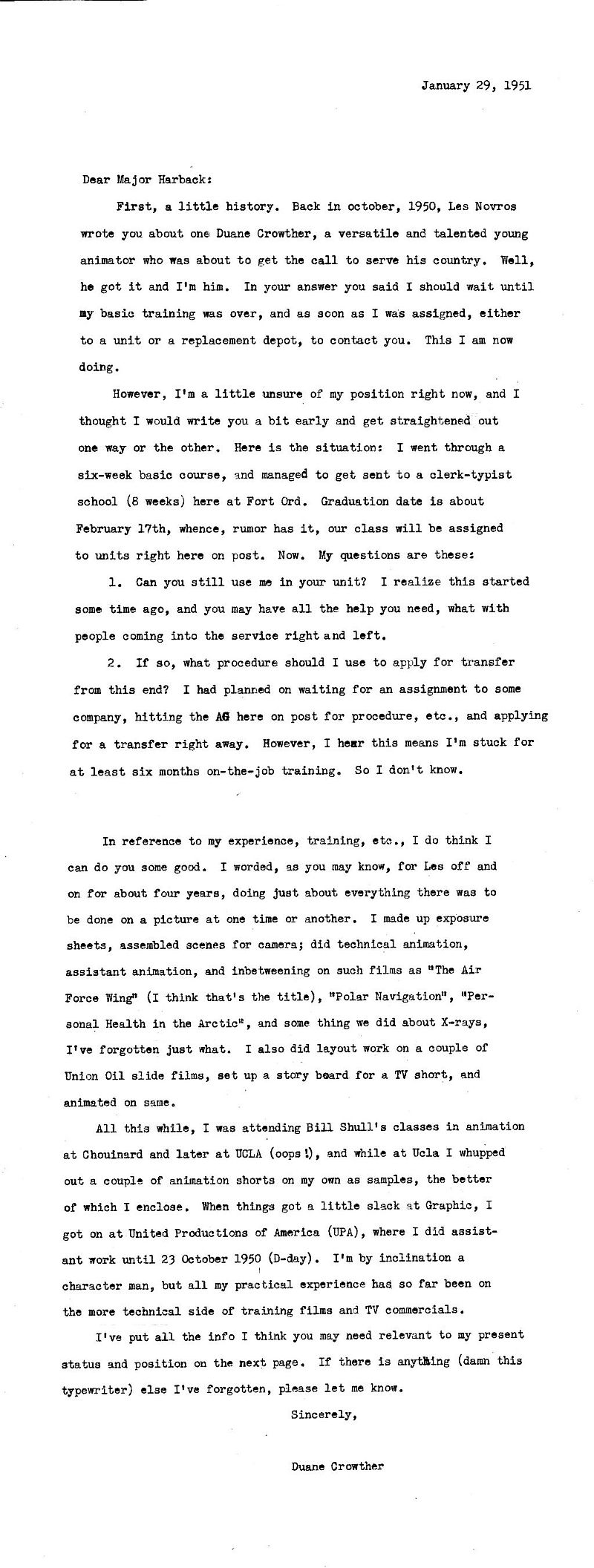
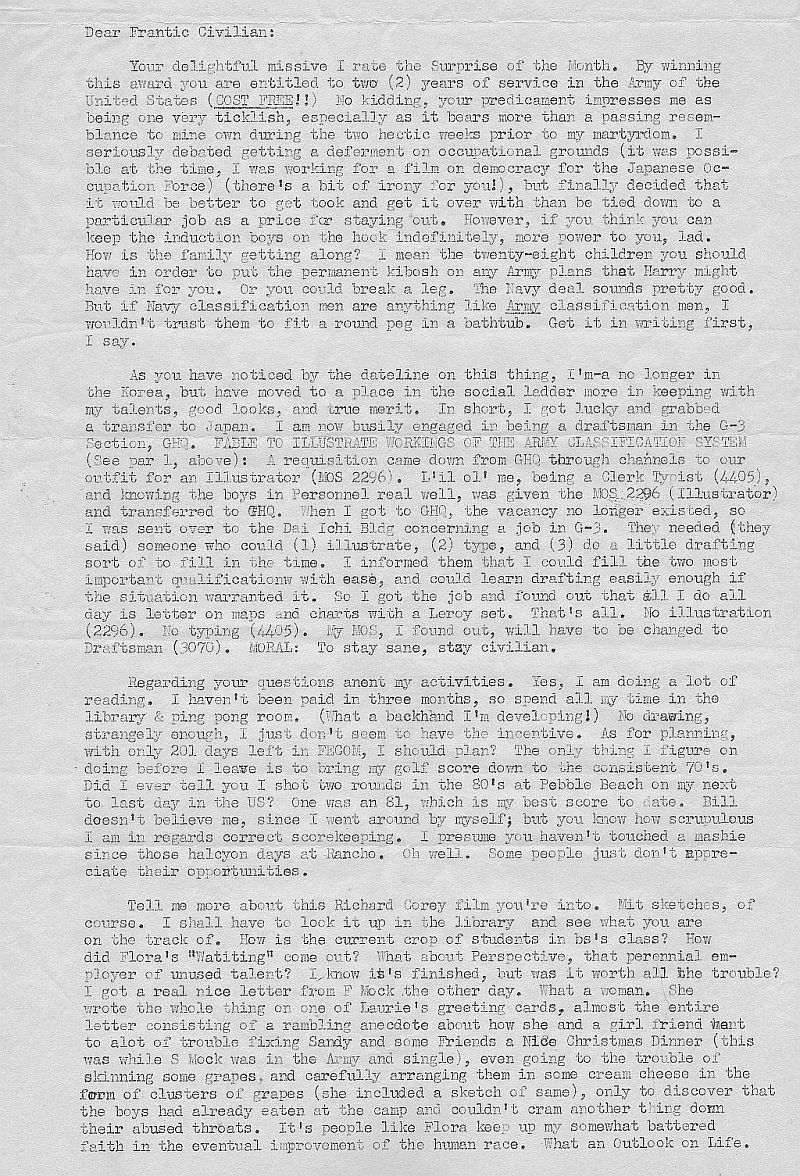


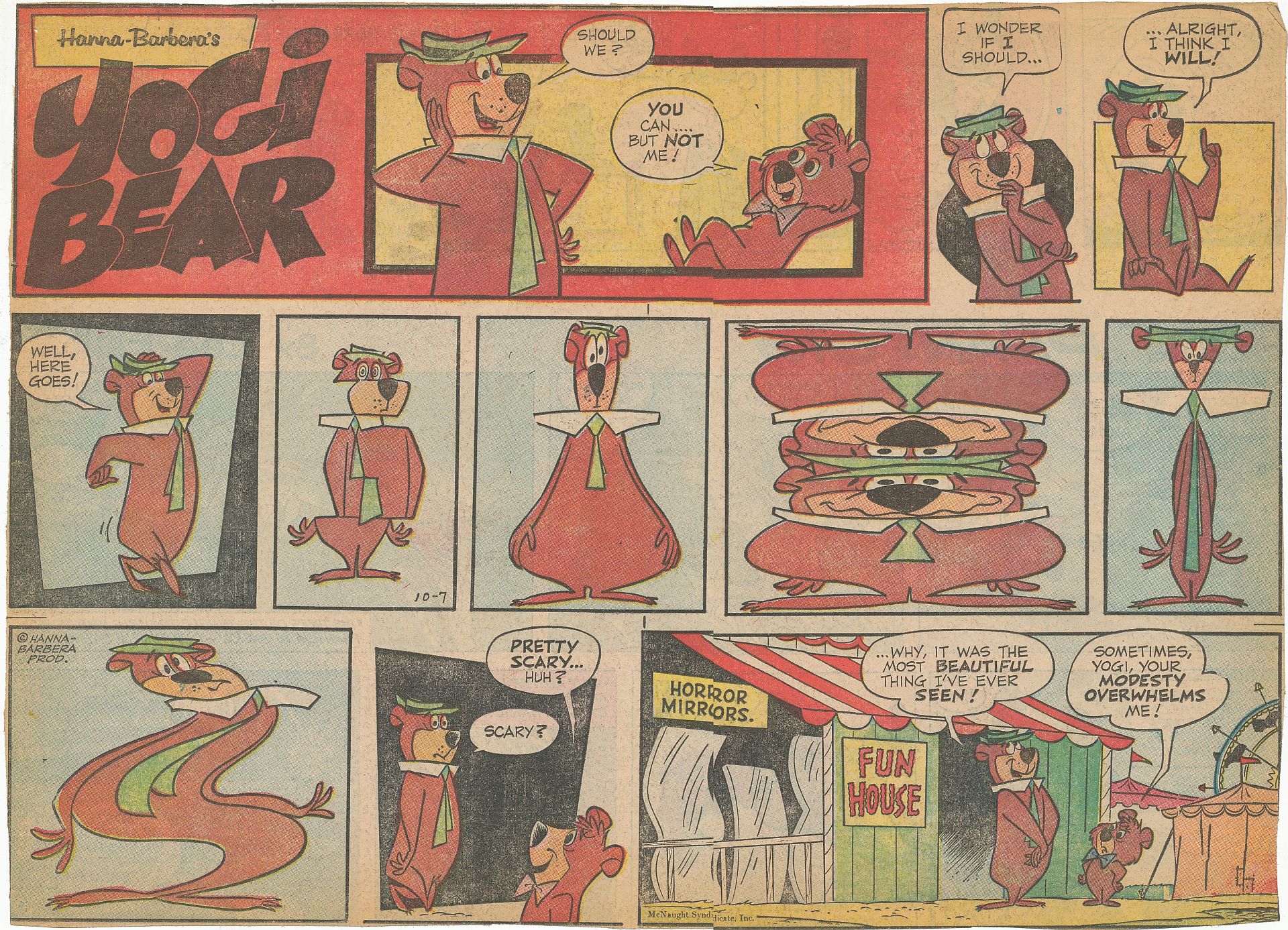
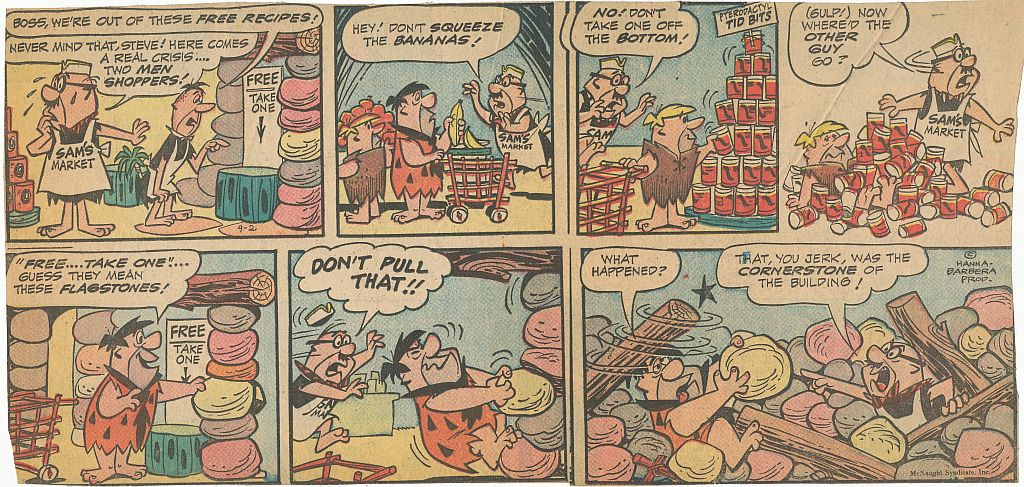
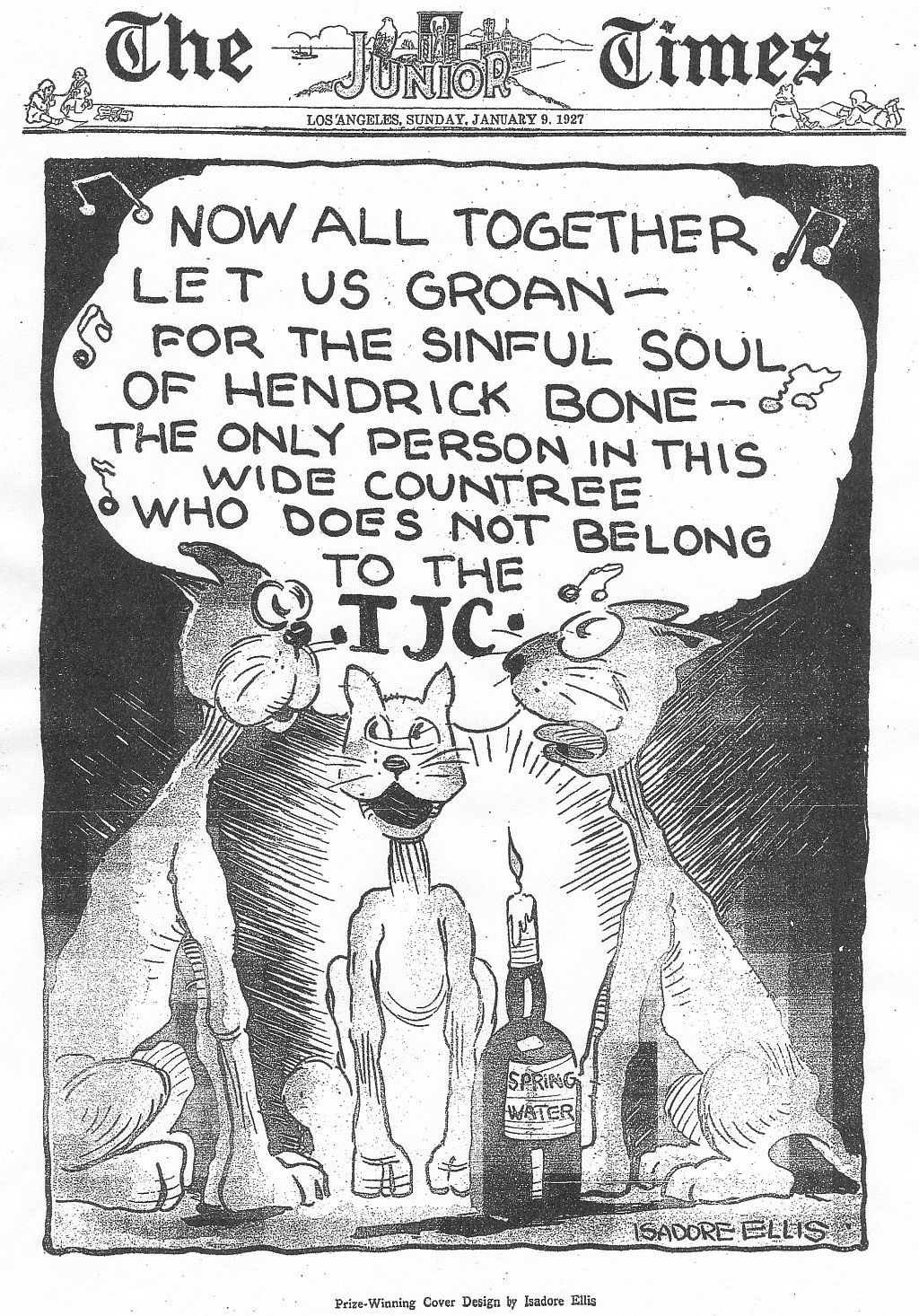
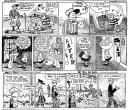

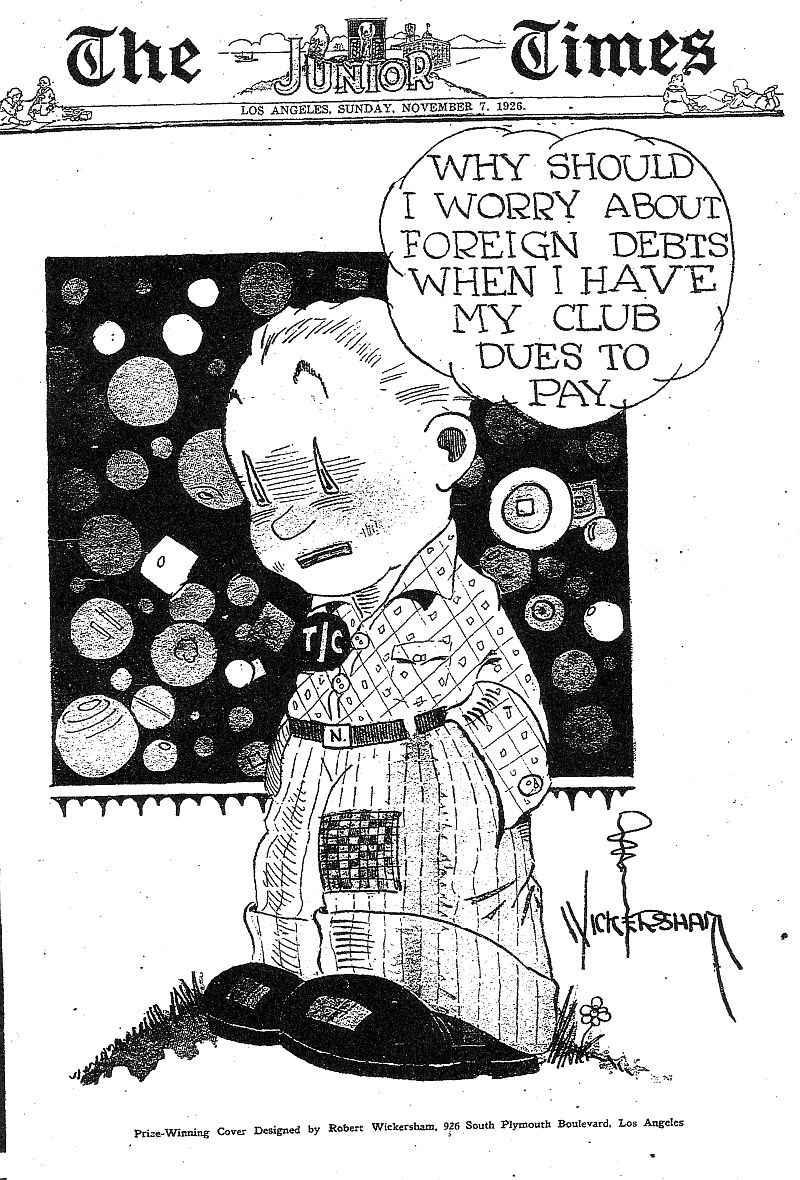

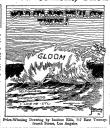







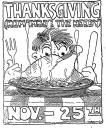
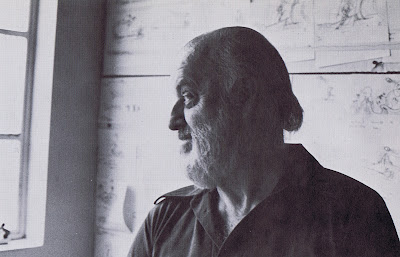

The Junior Times Feb. 1927
November 7, 2012
Uncategorized
2 Comments
Mark